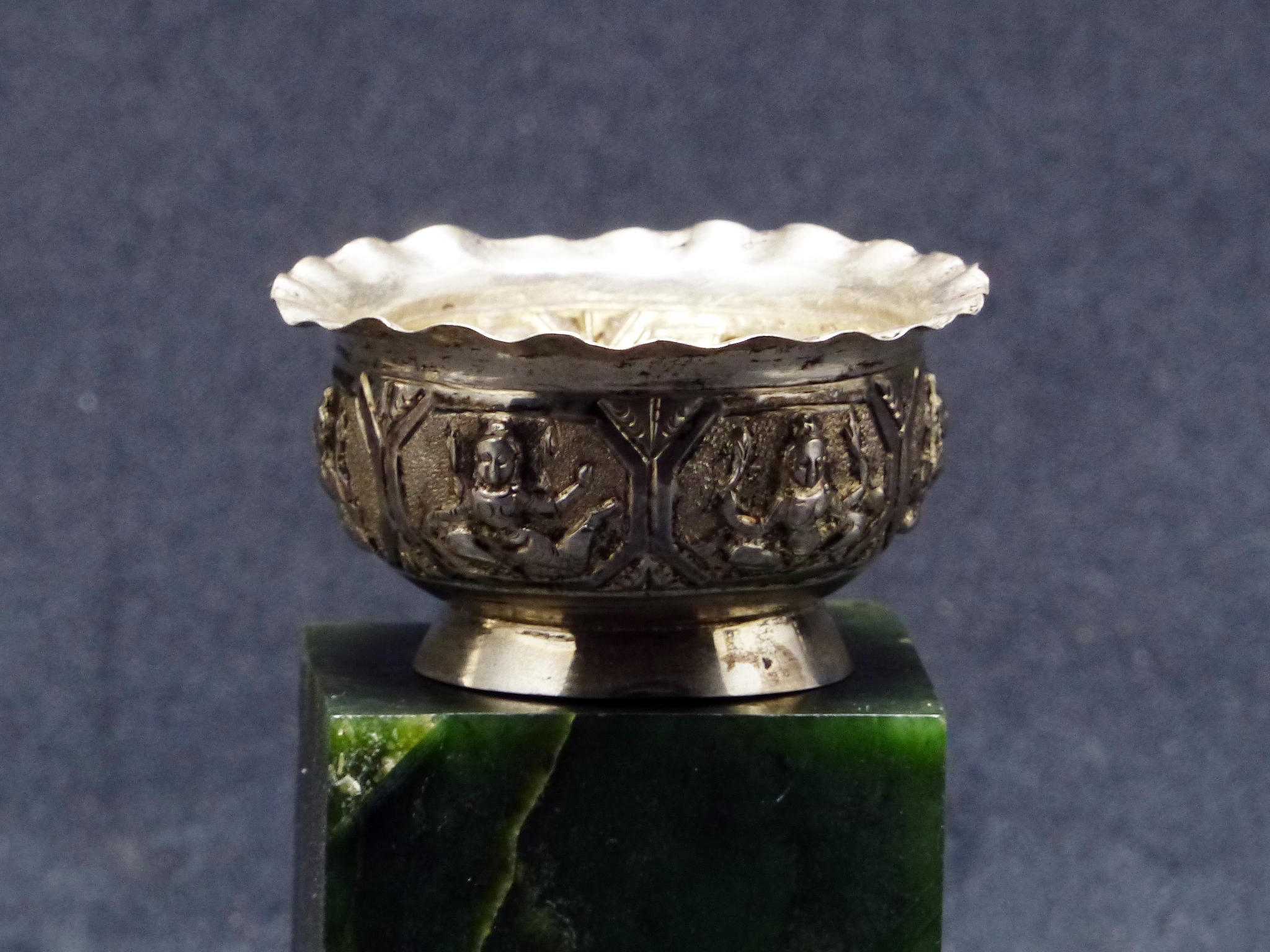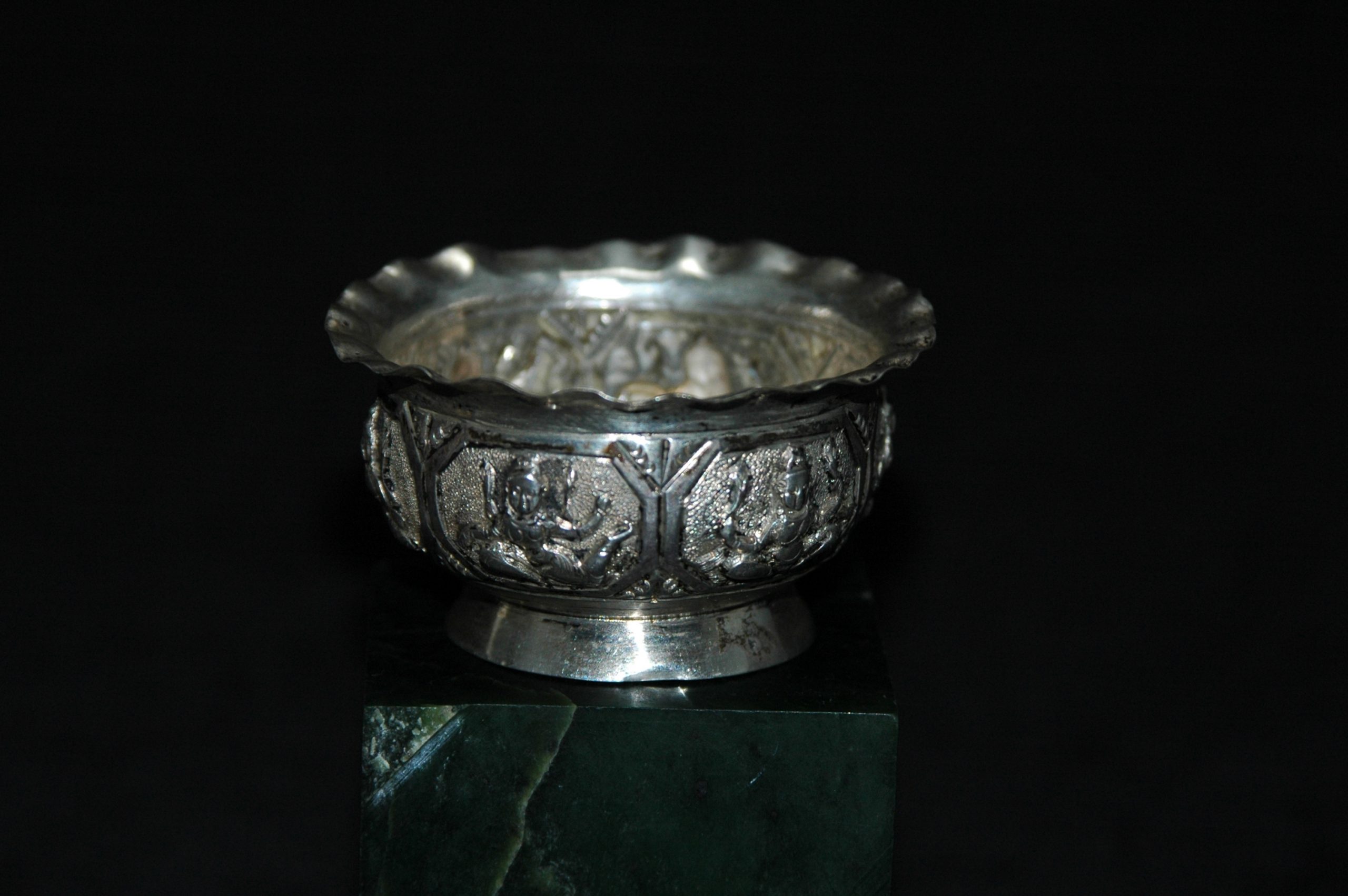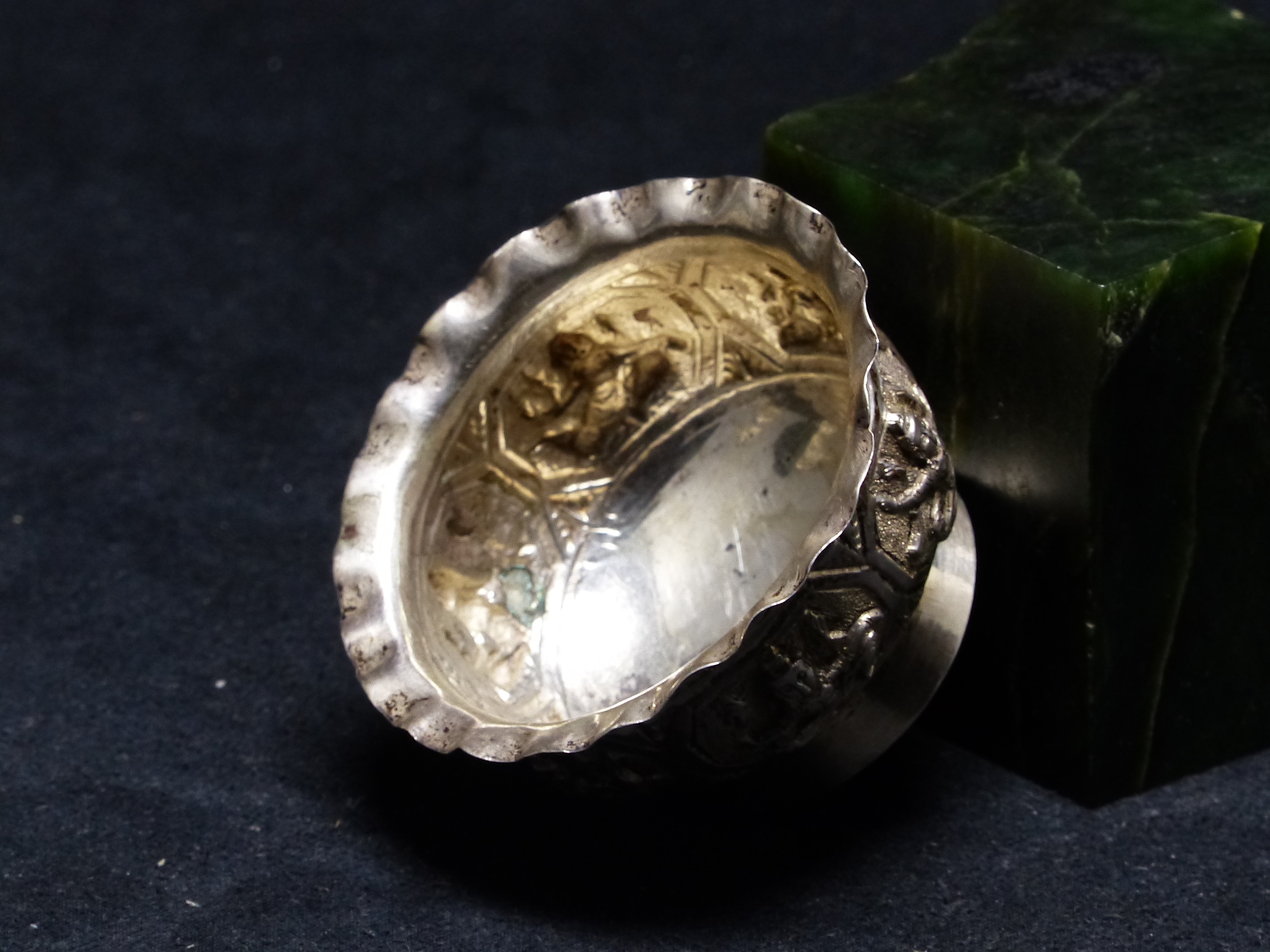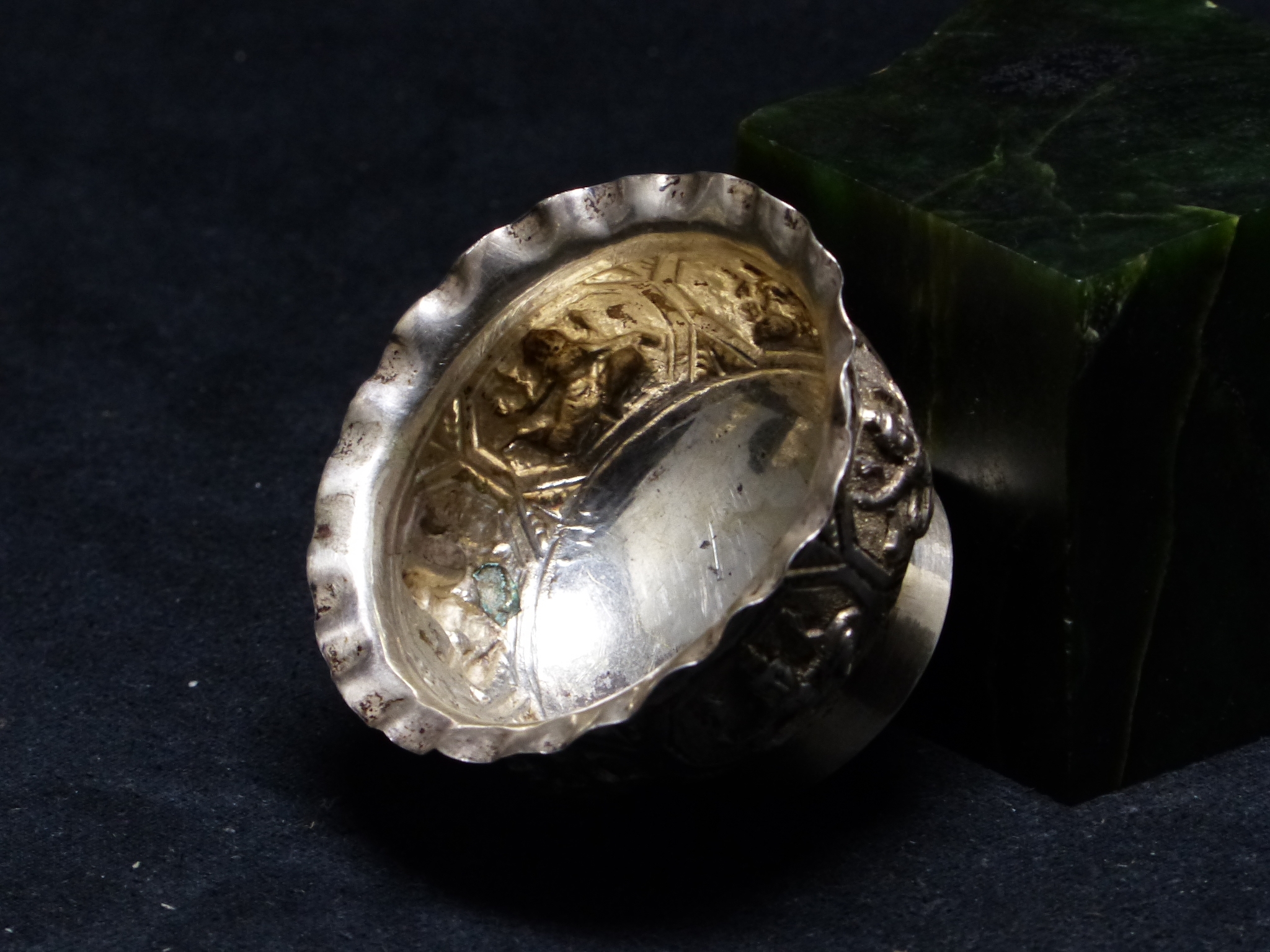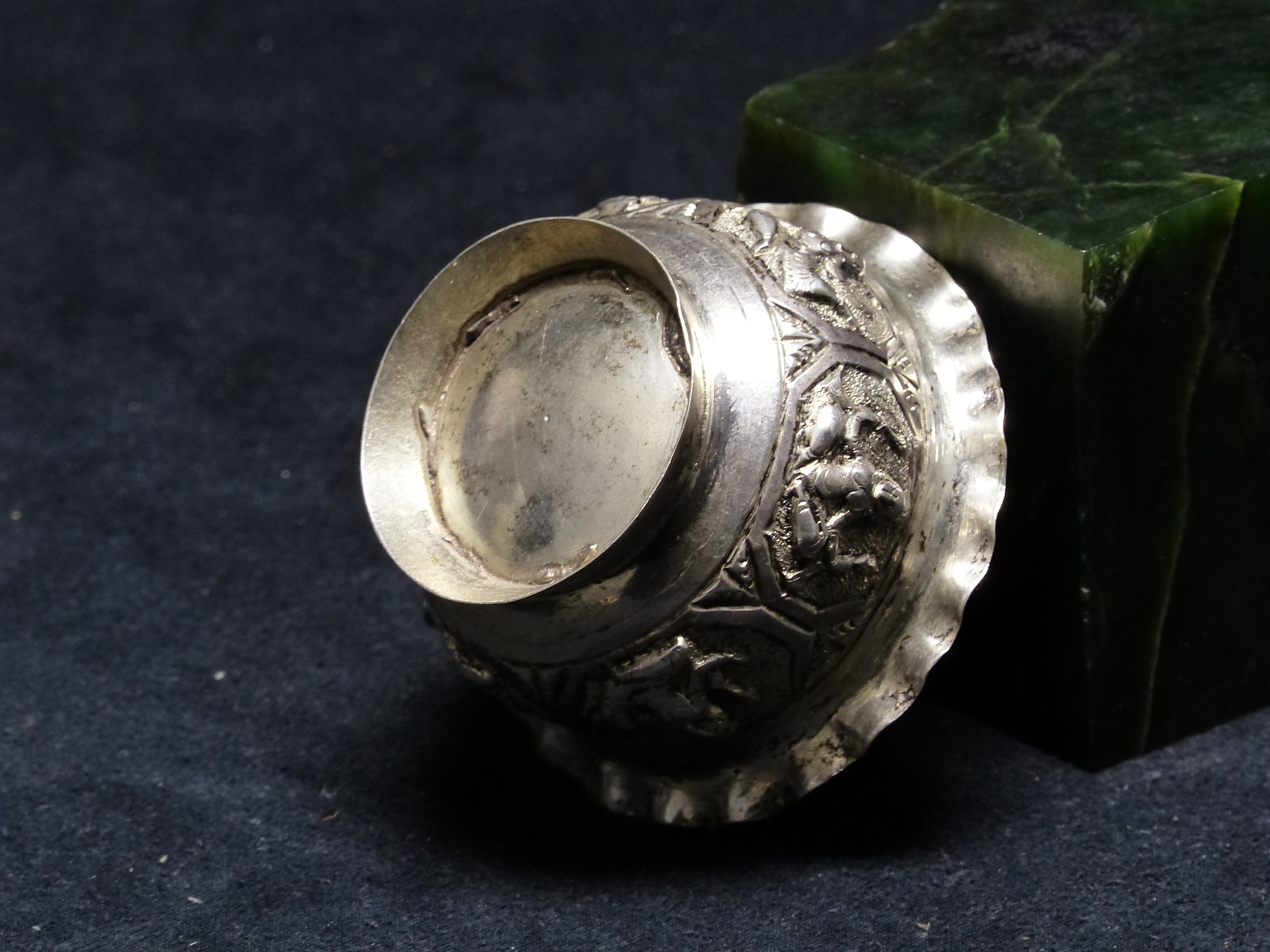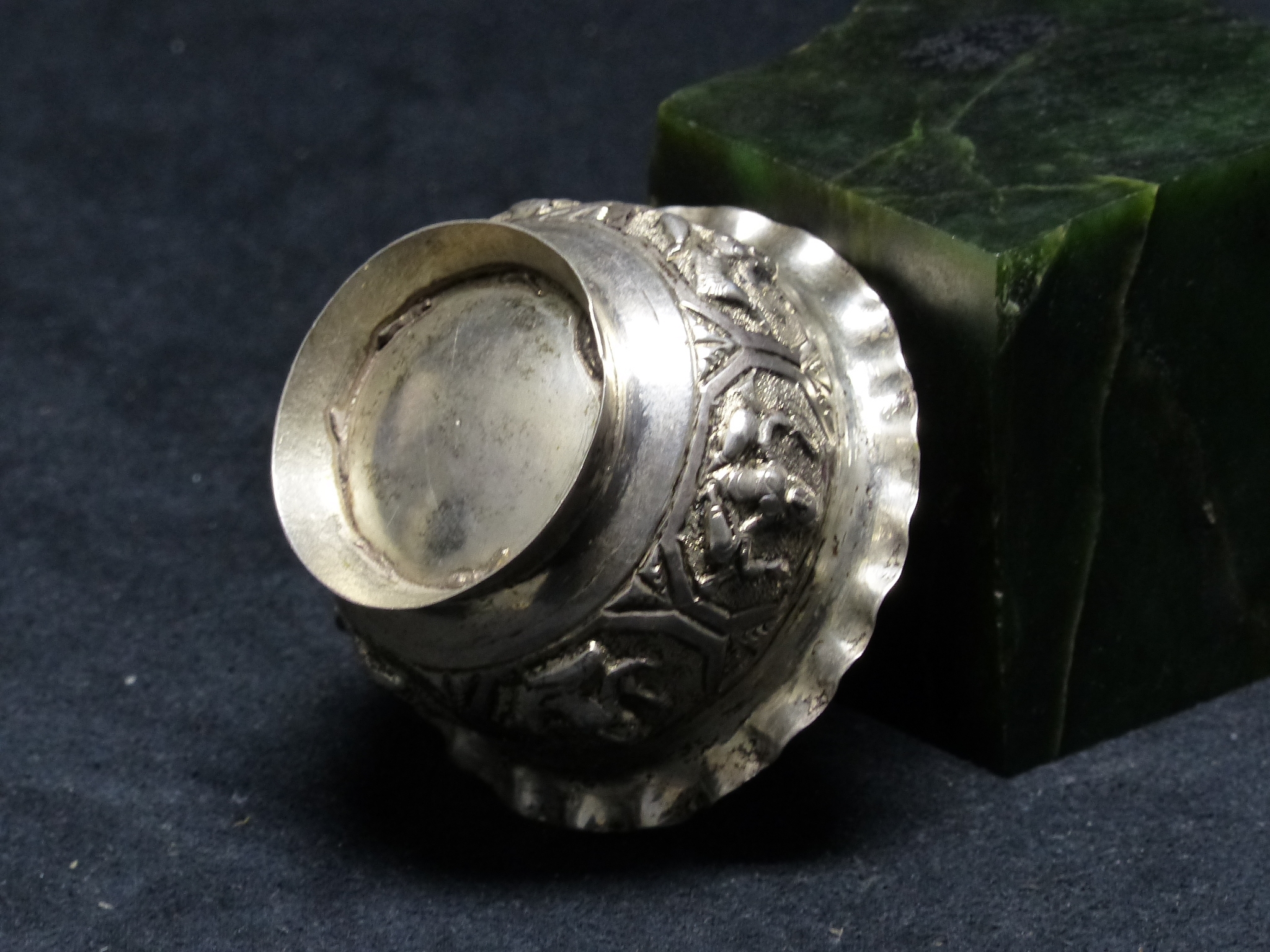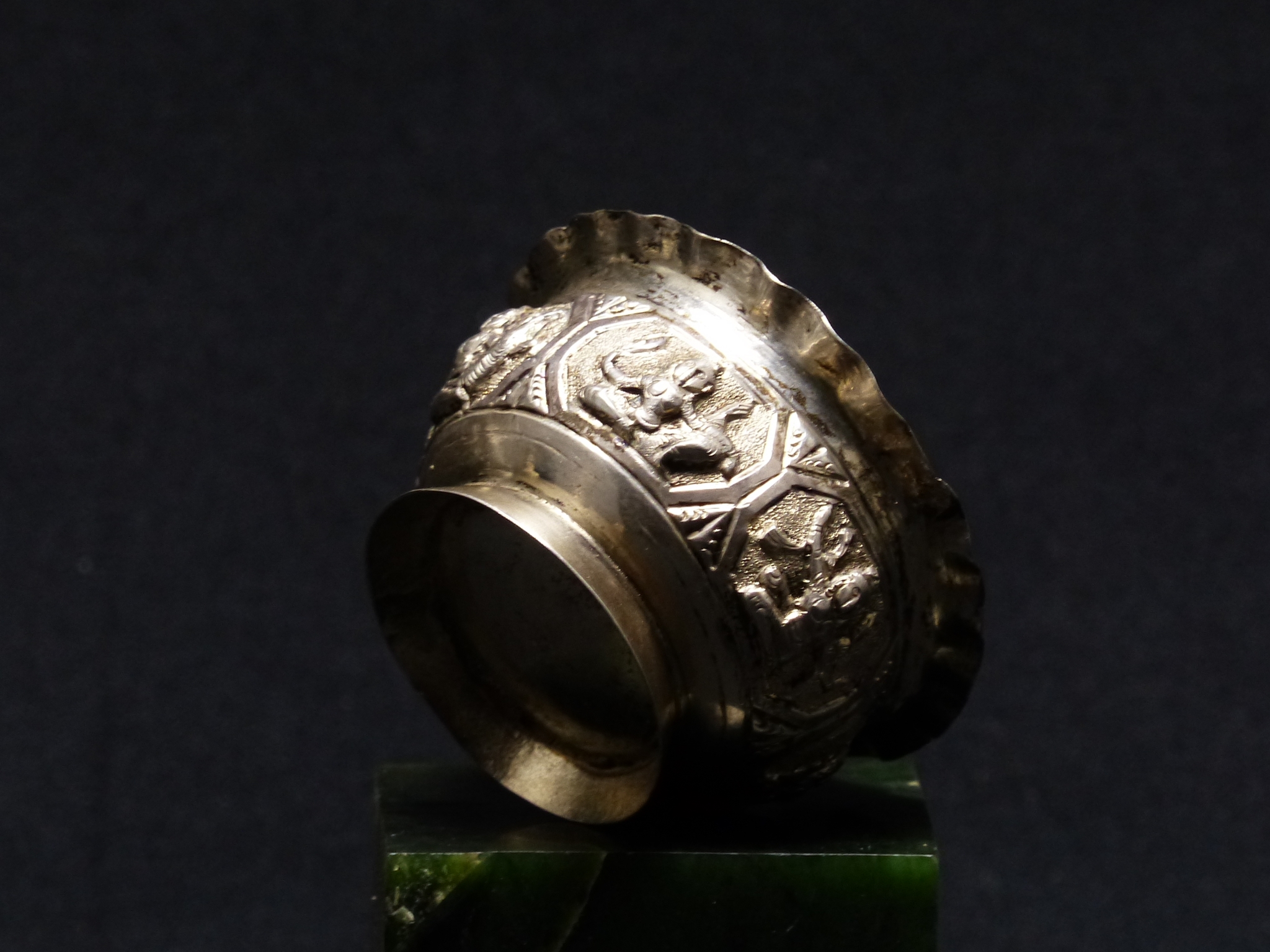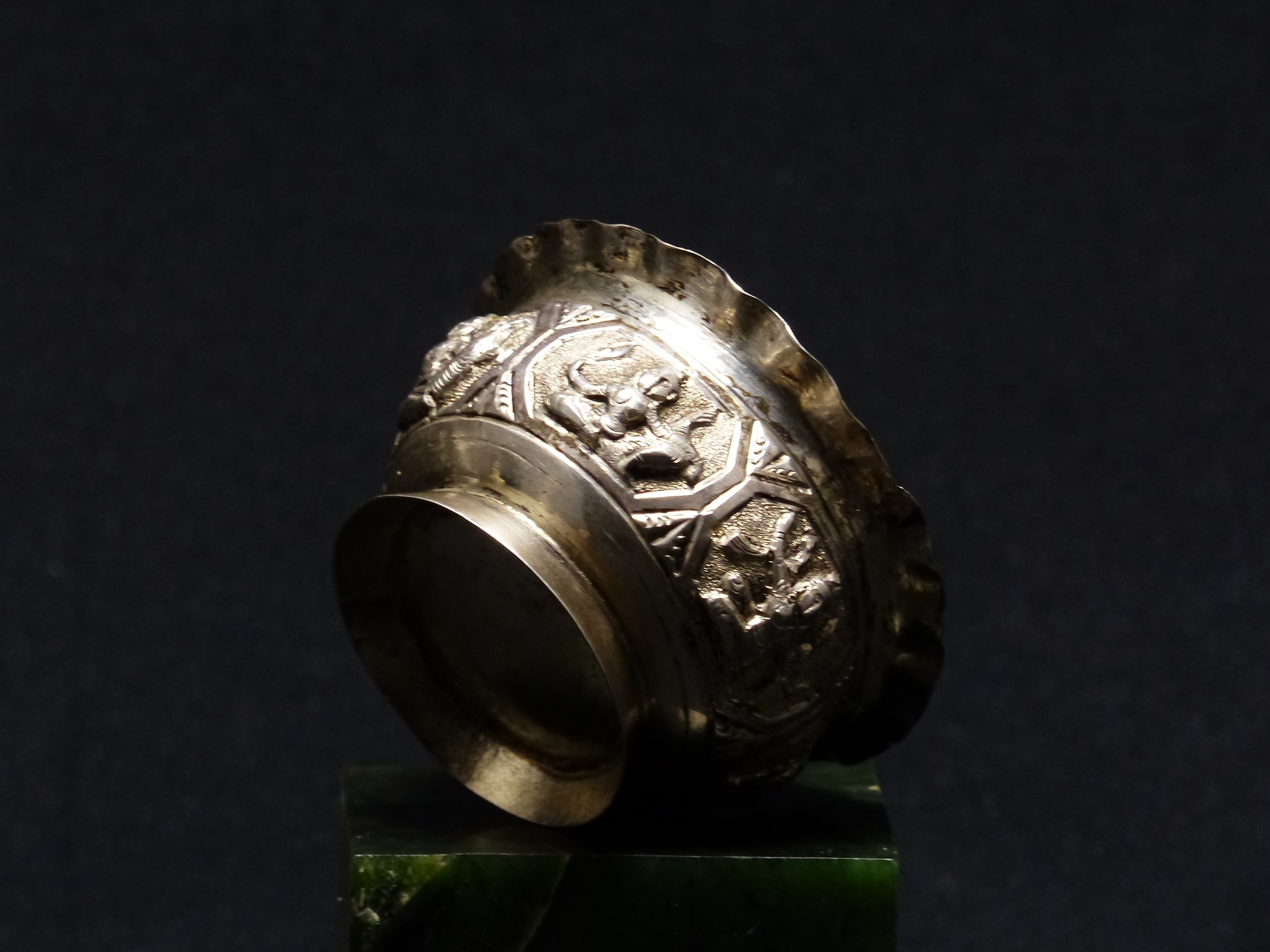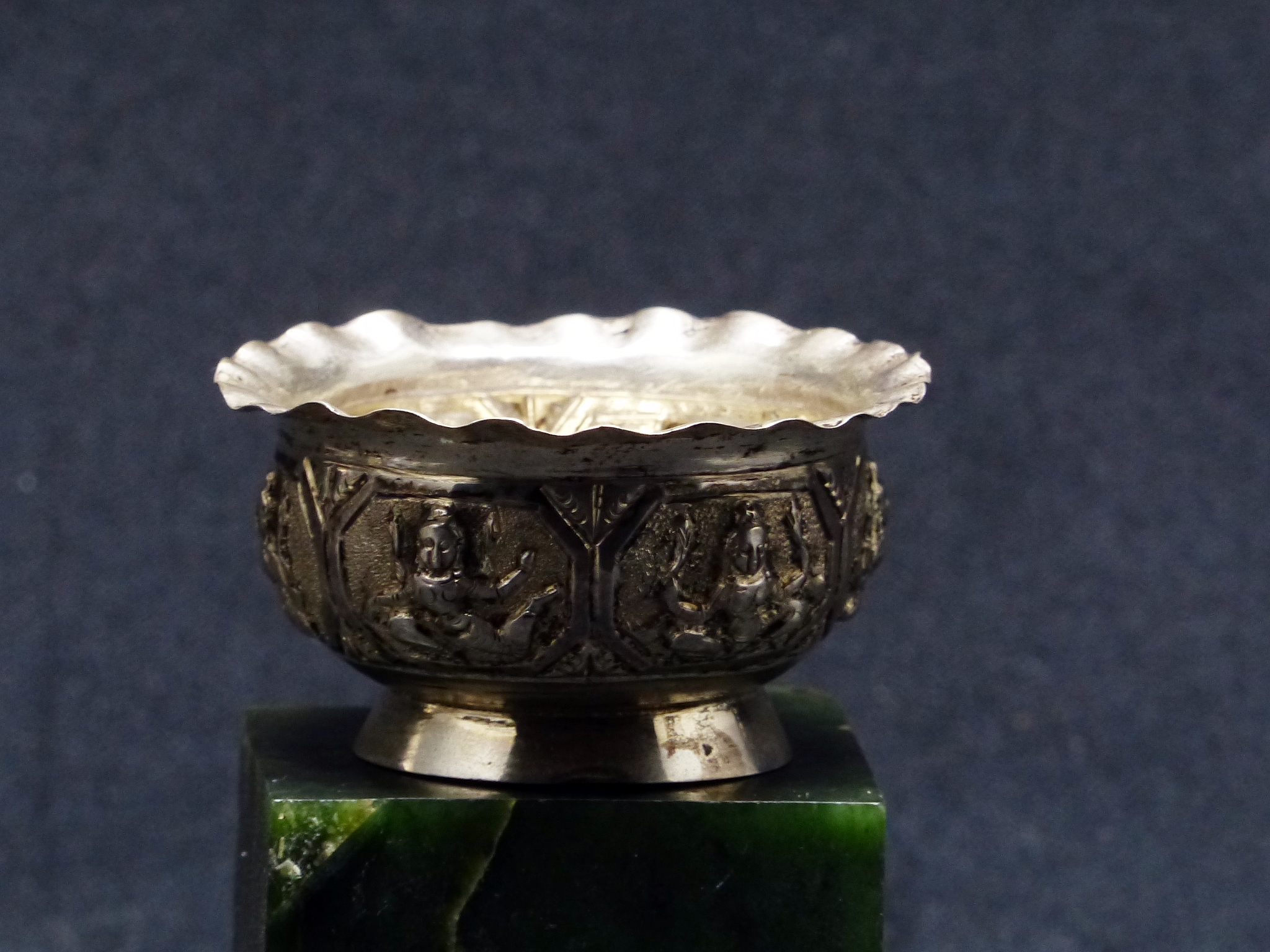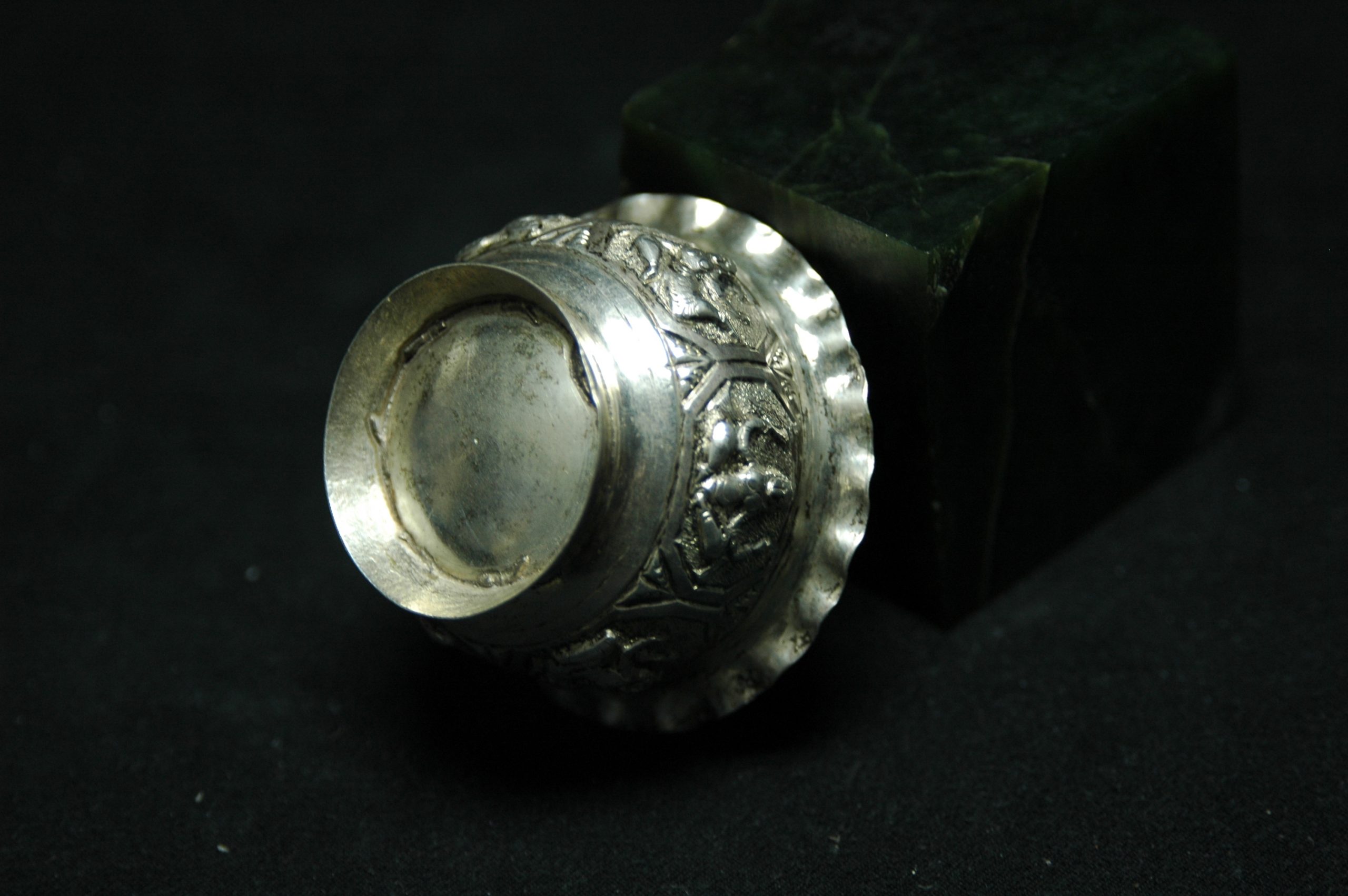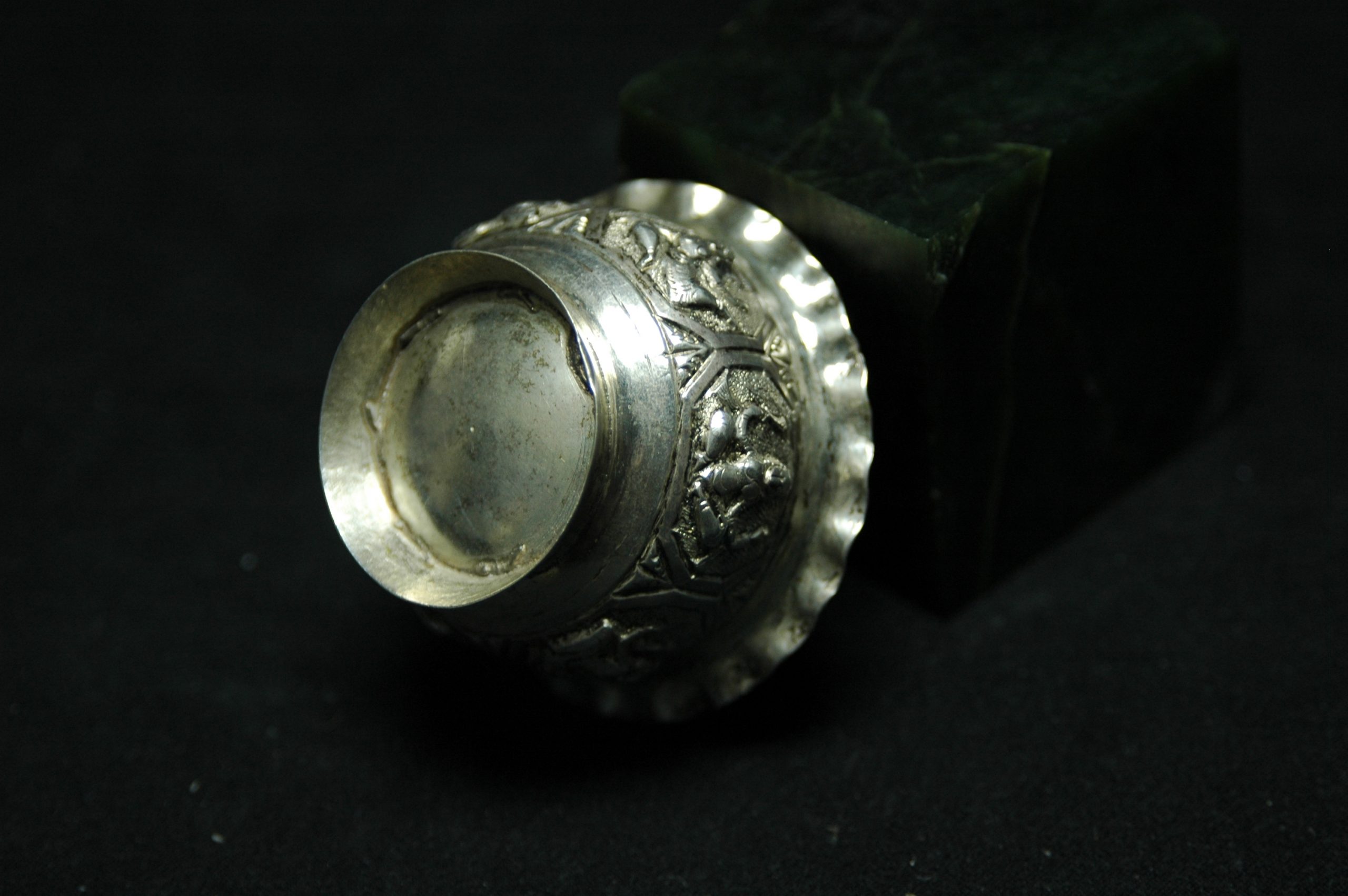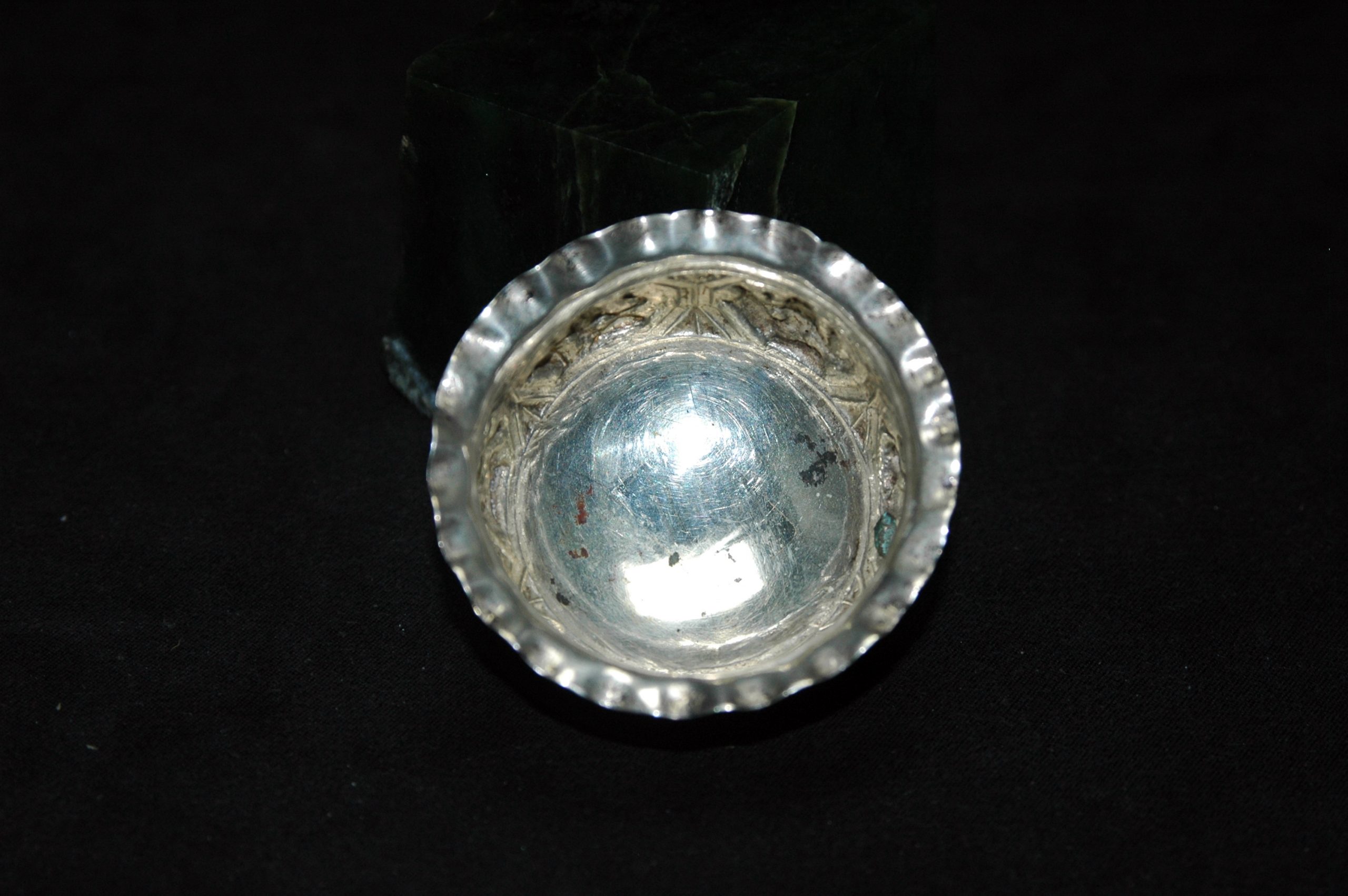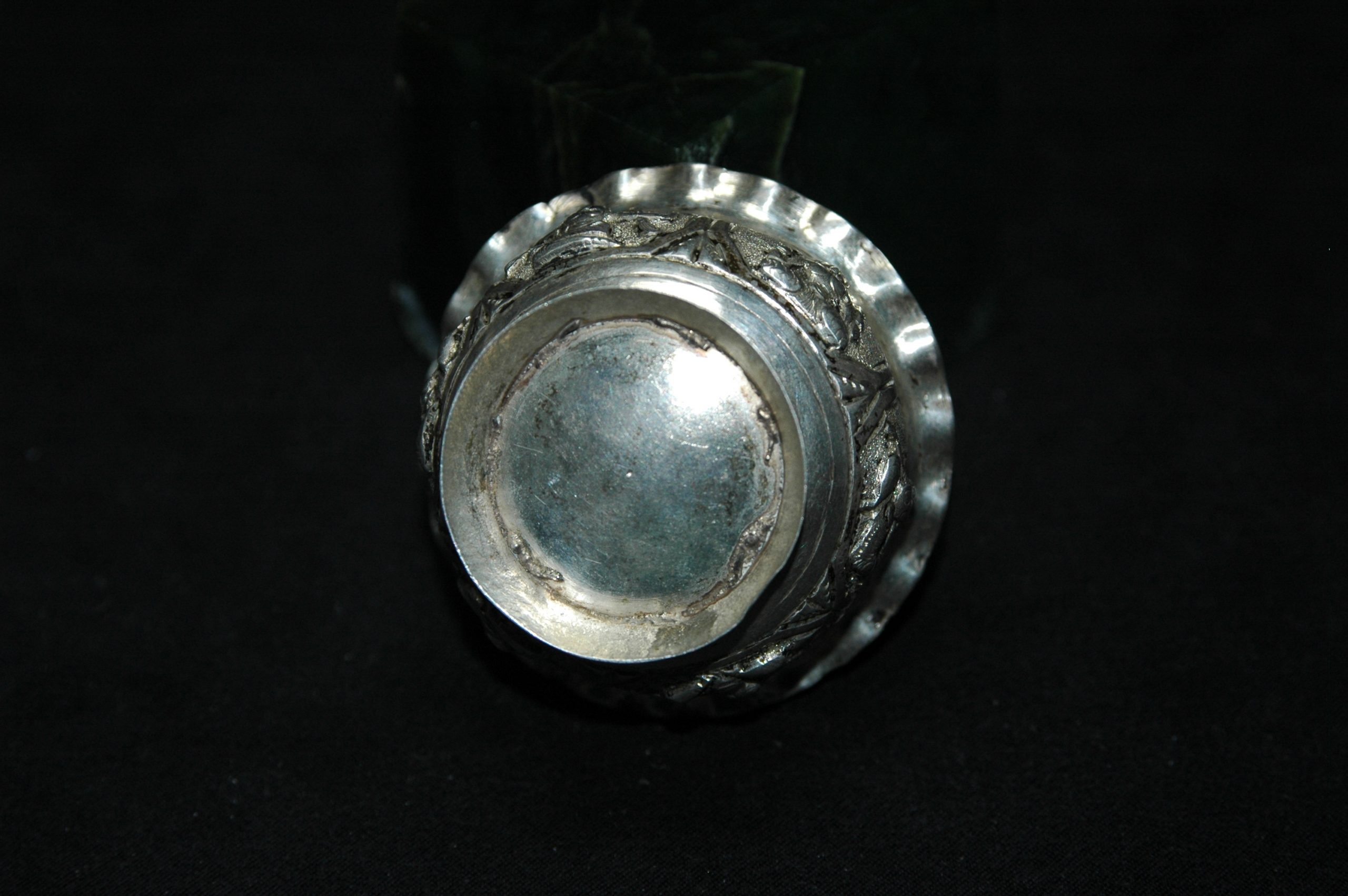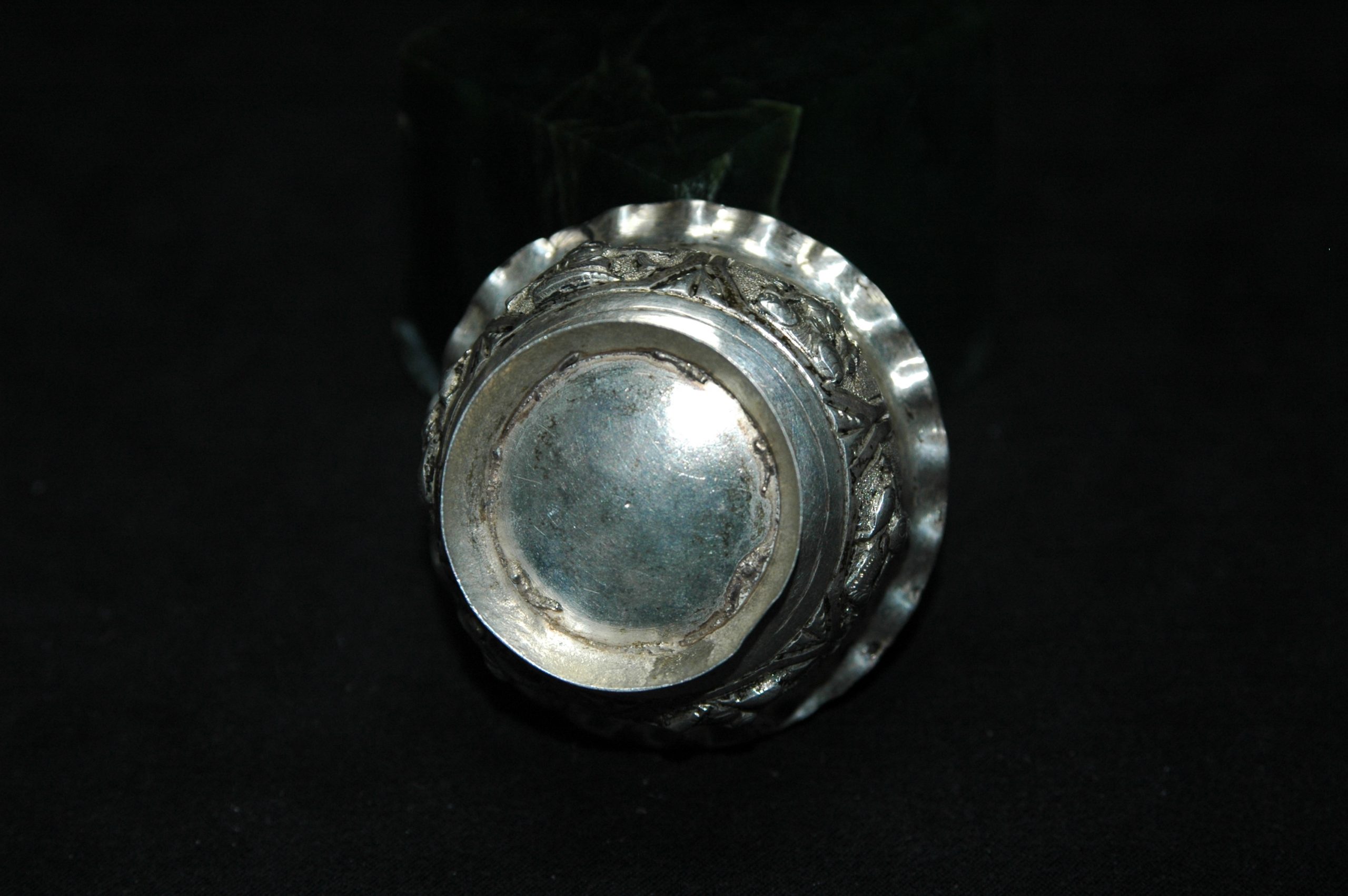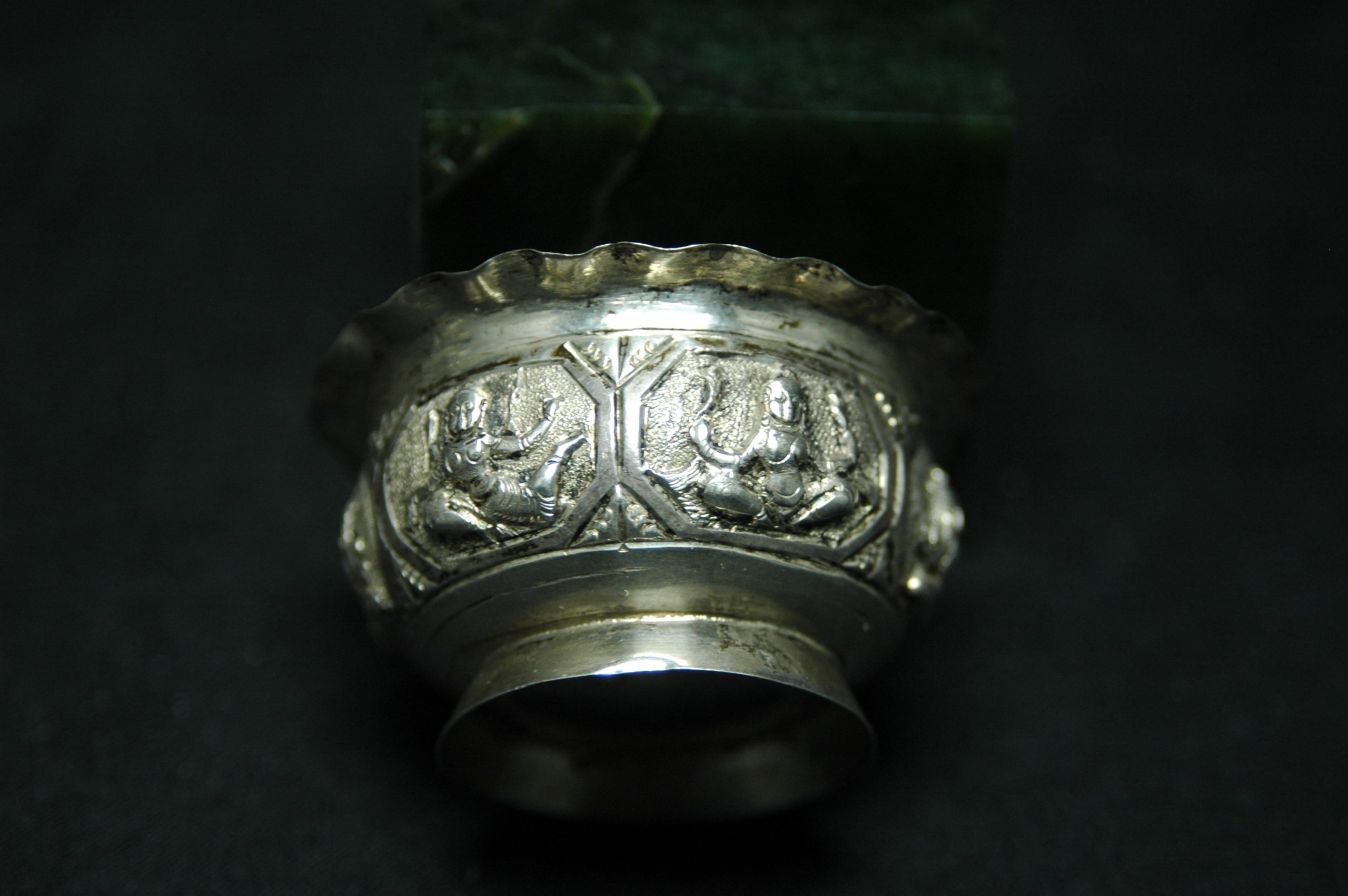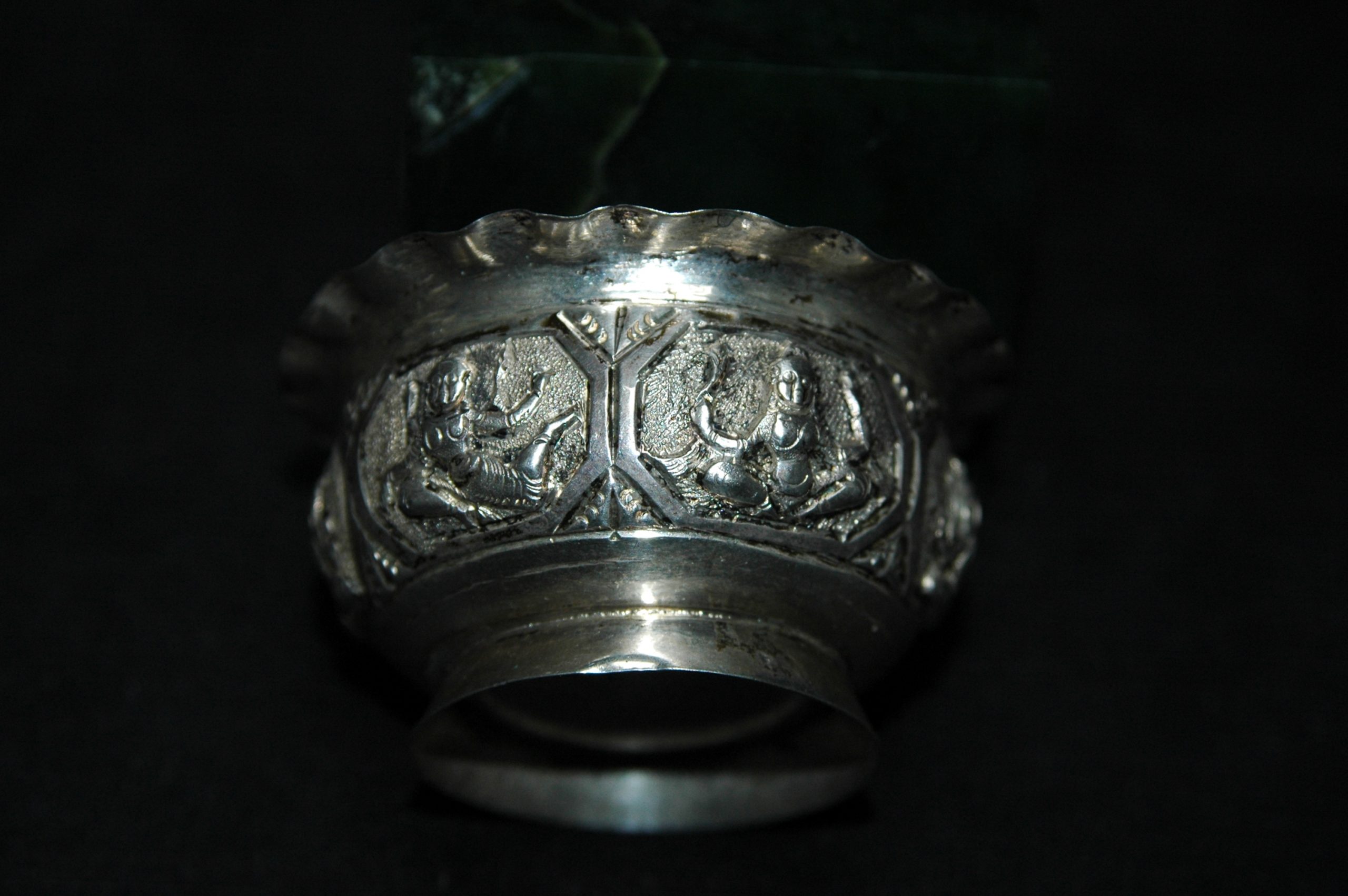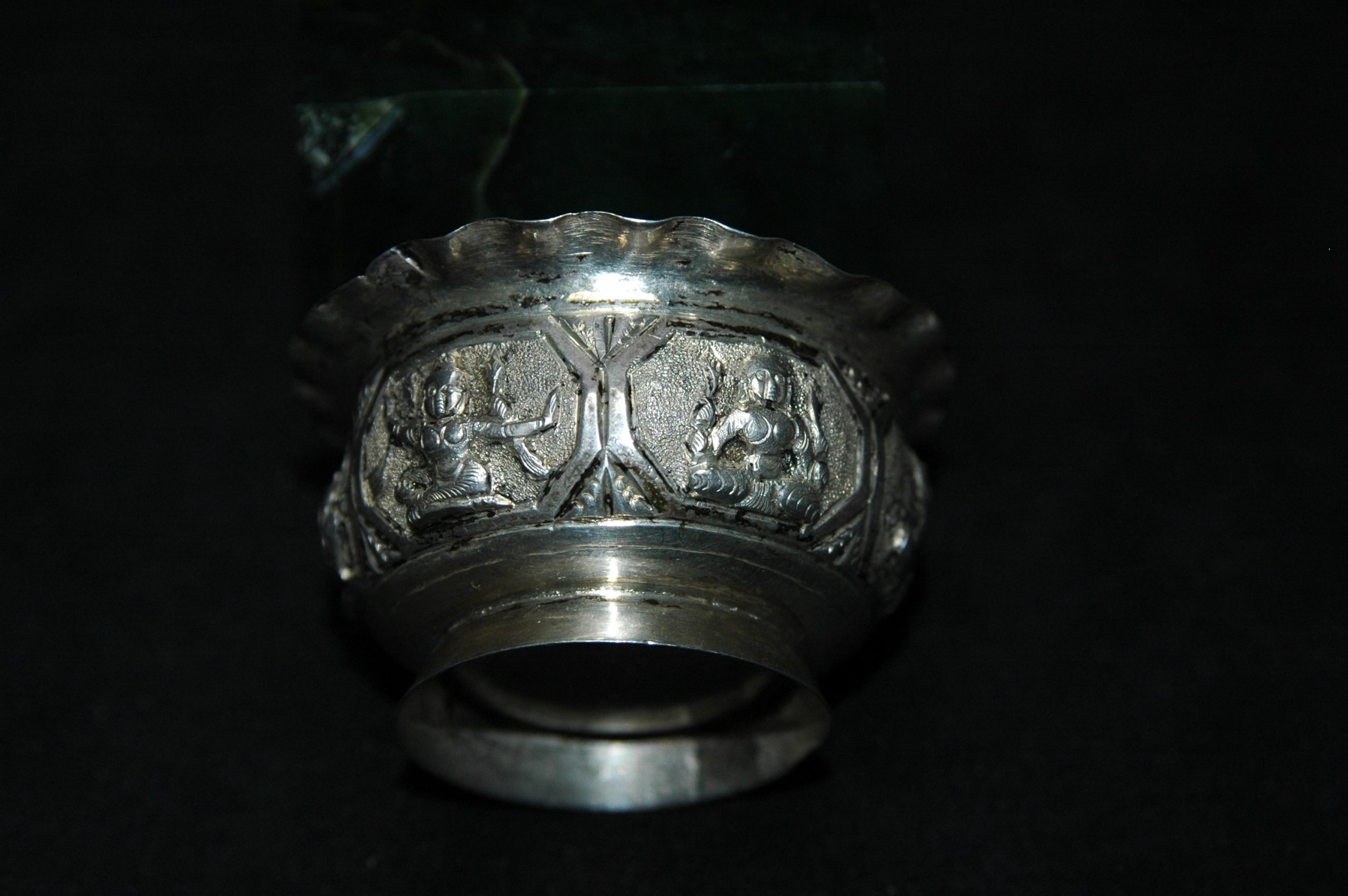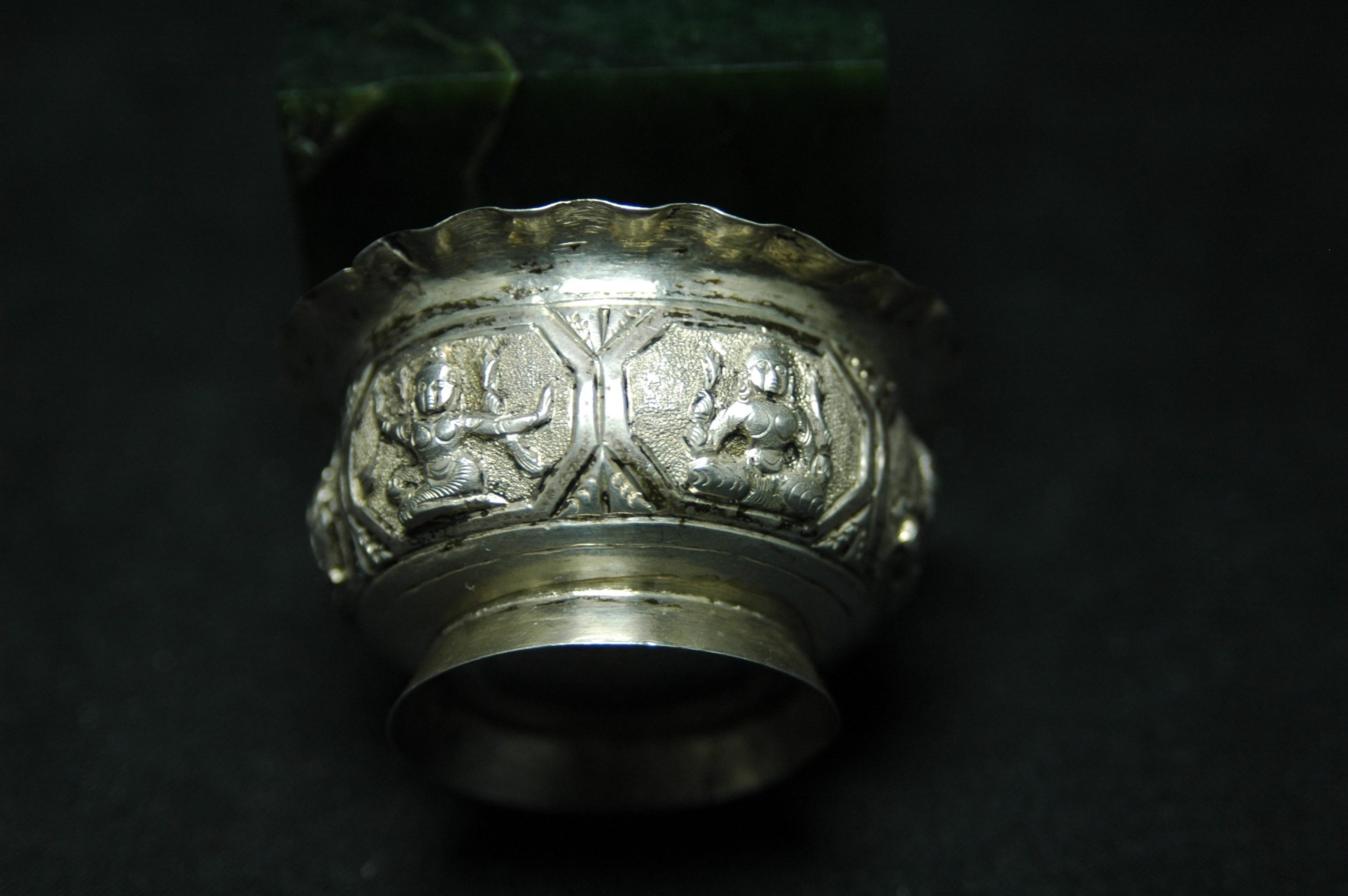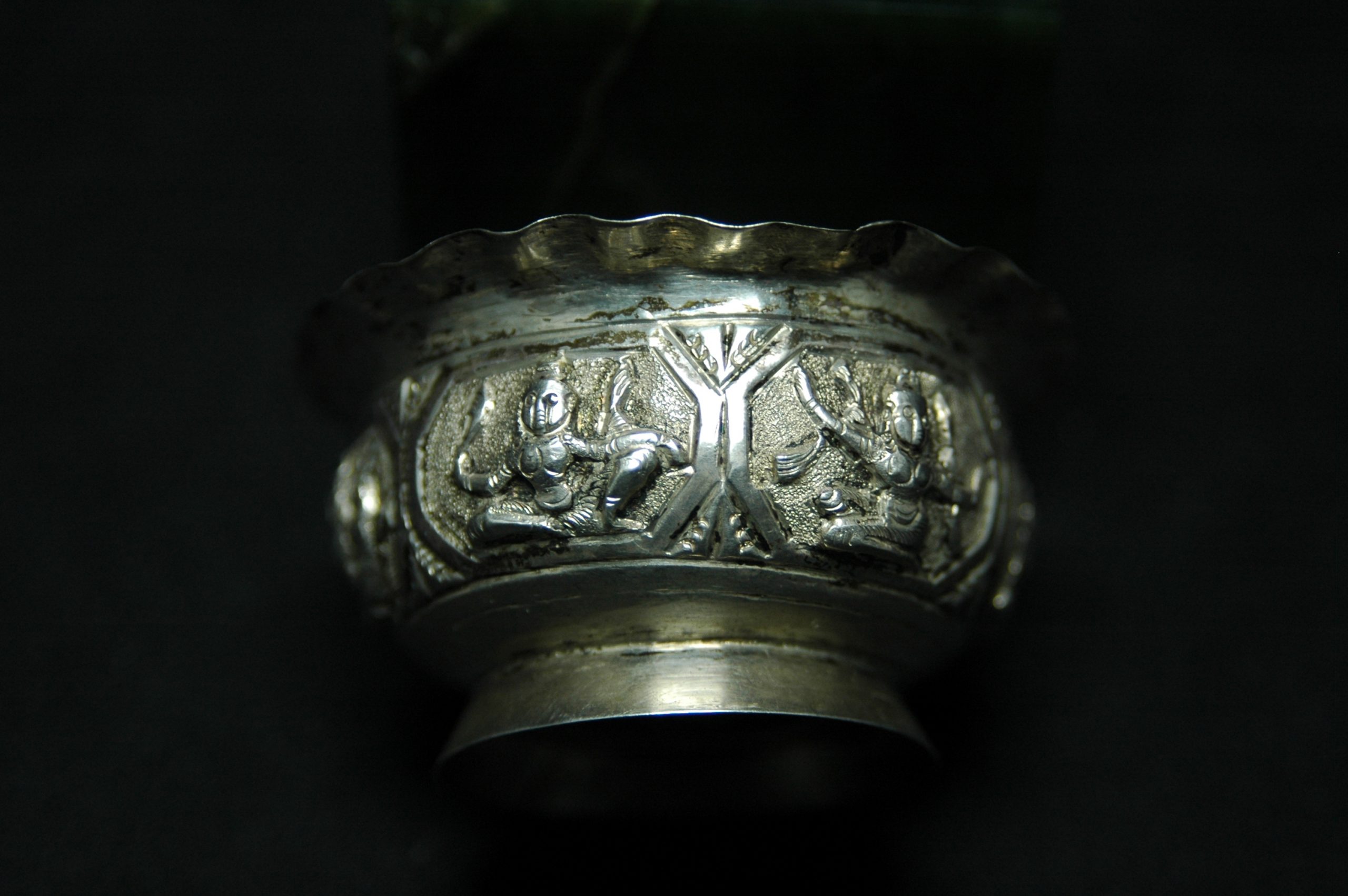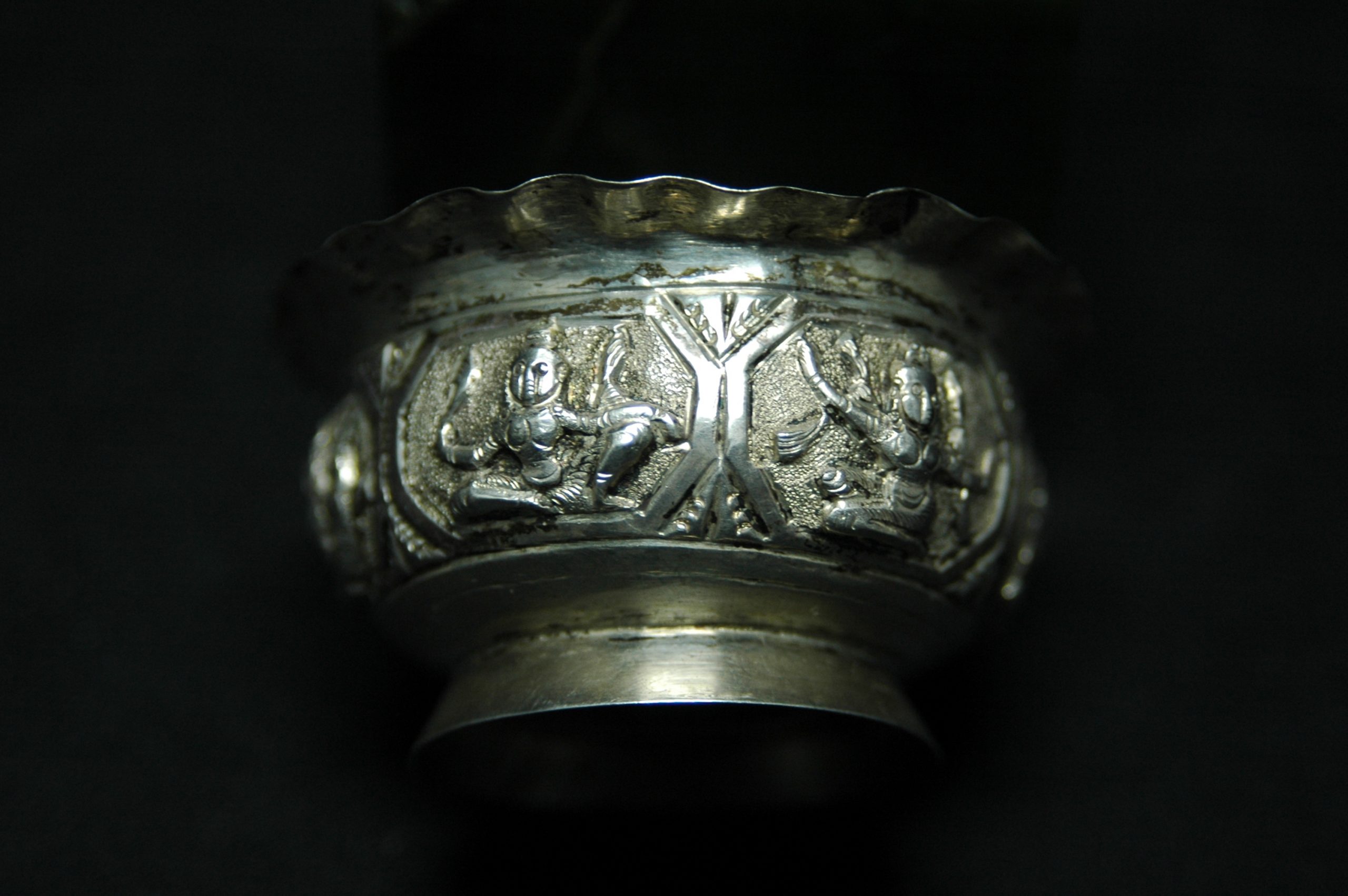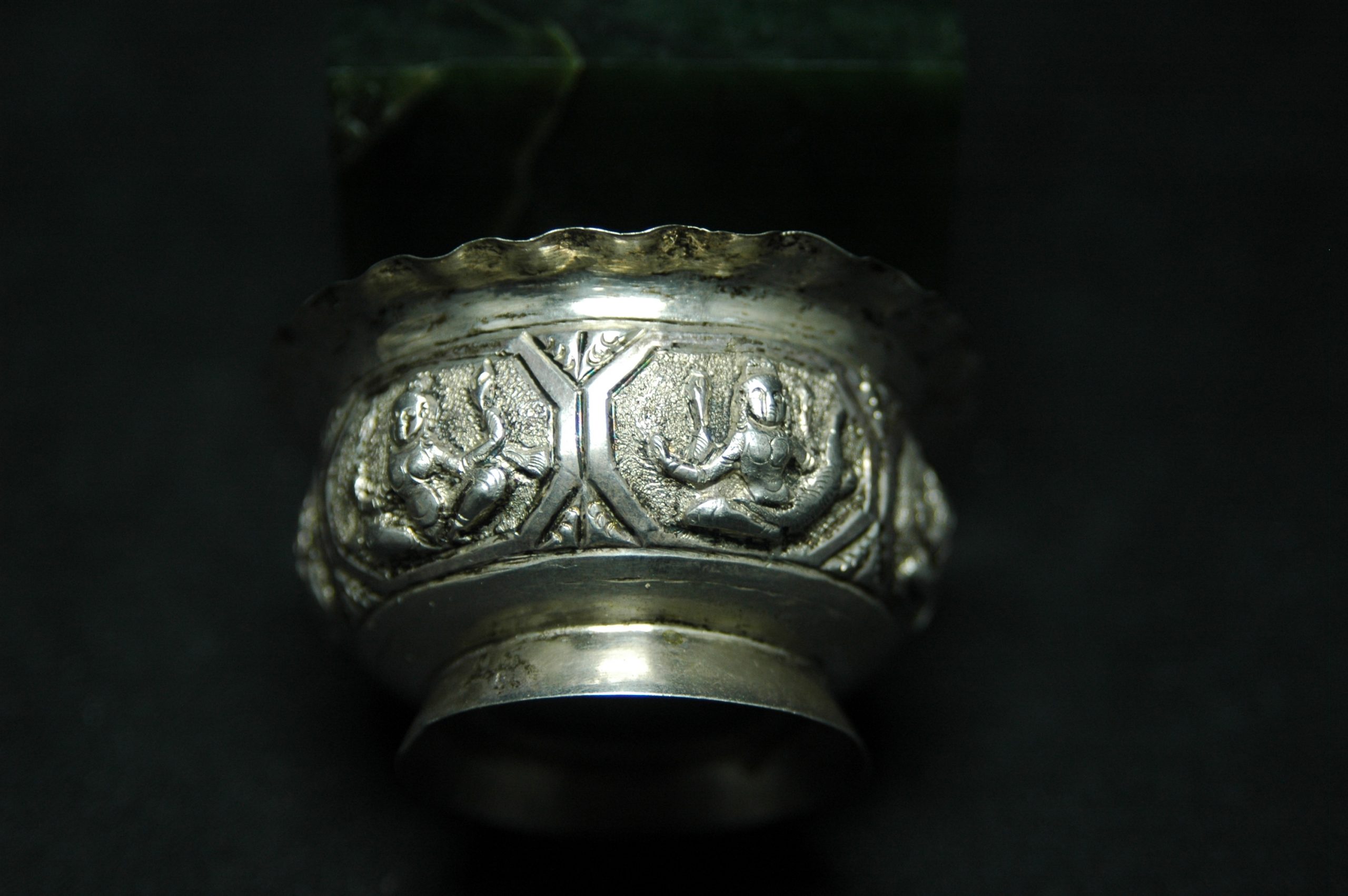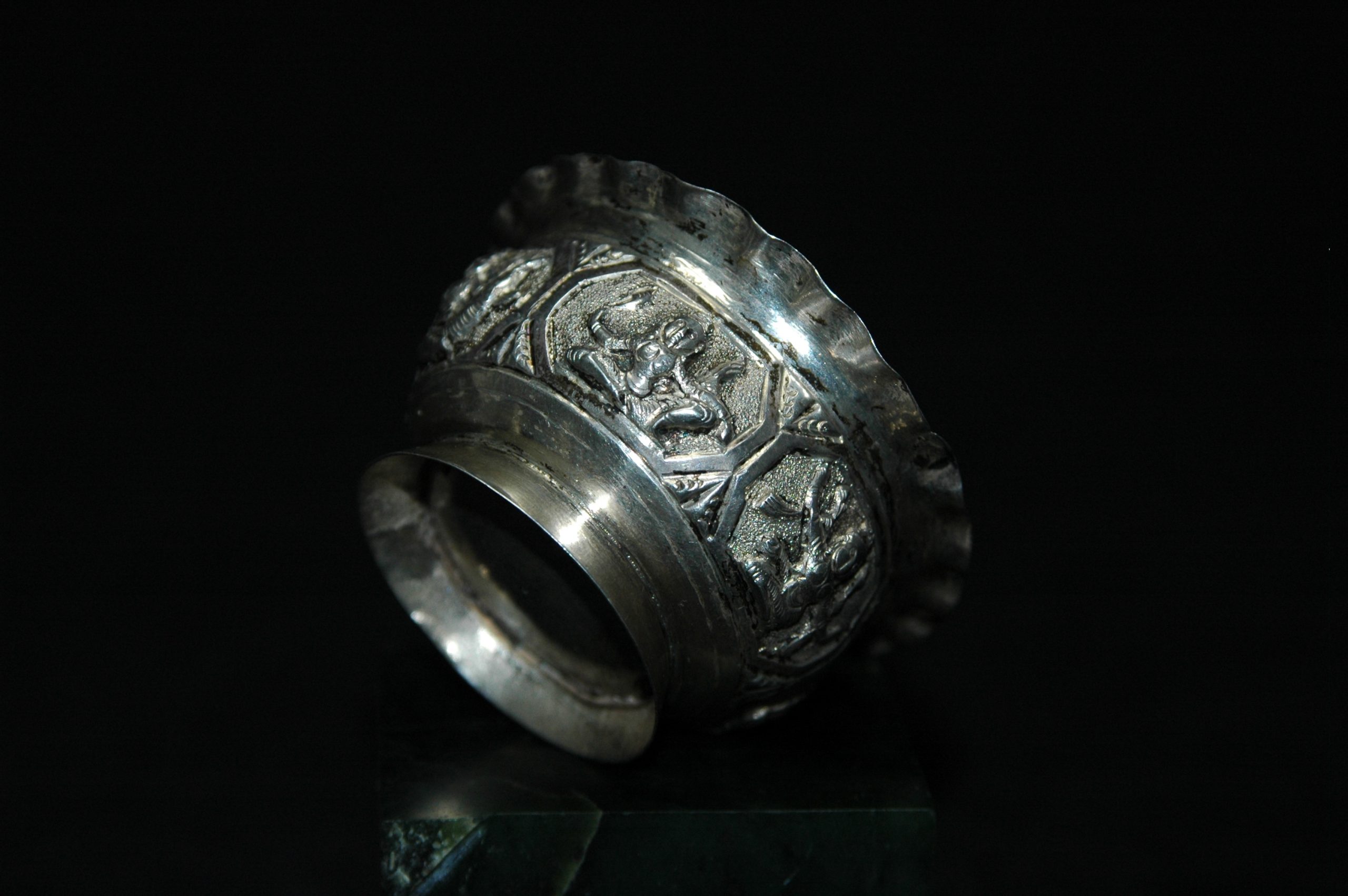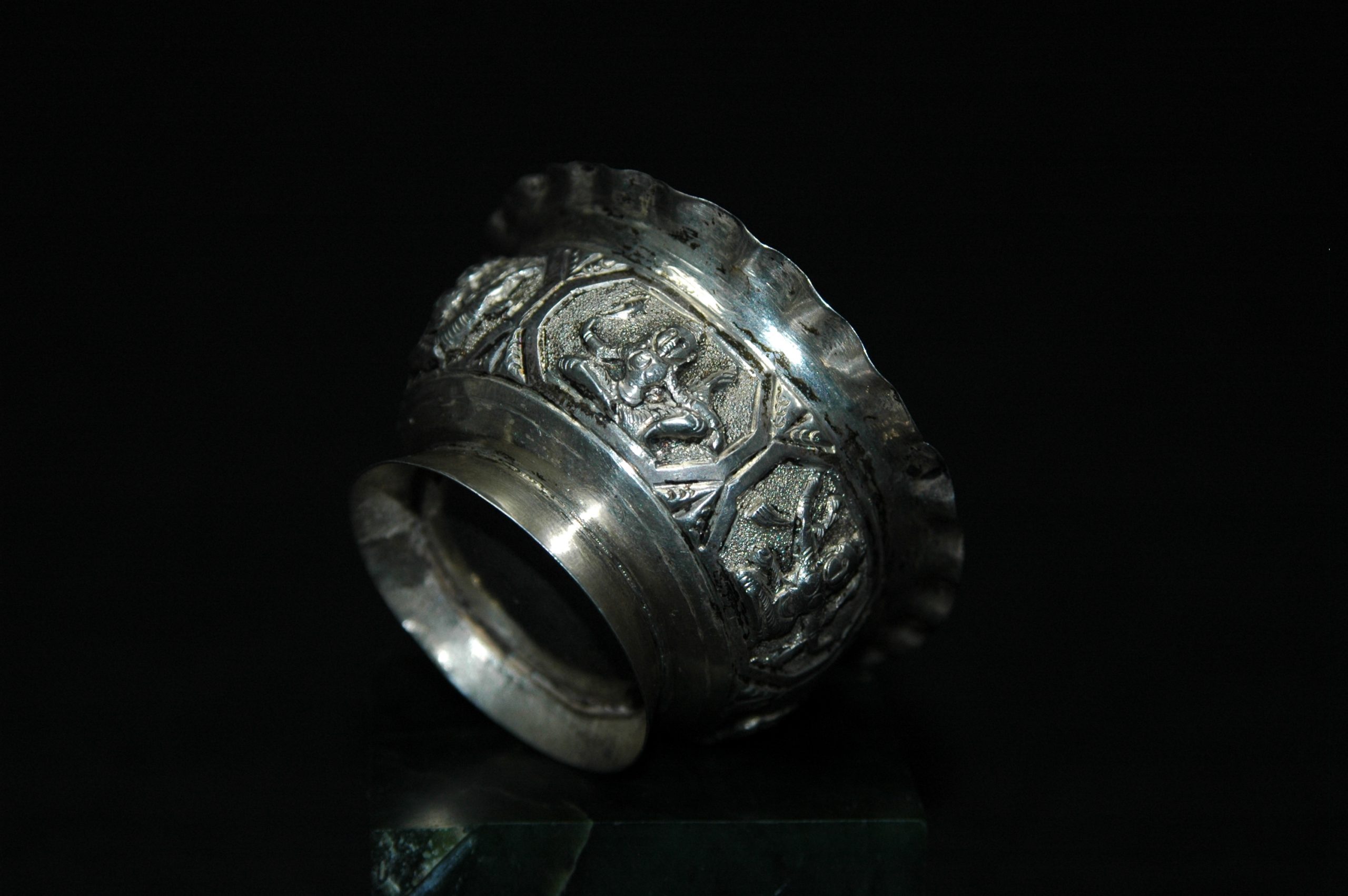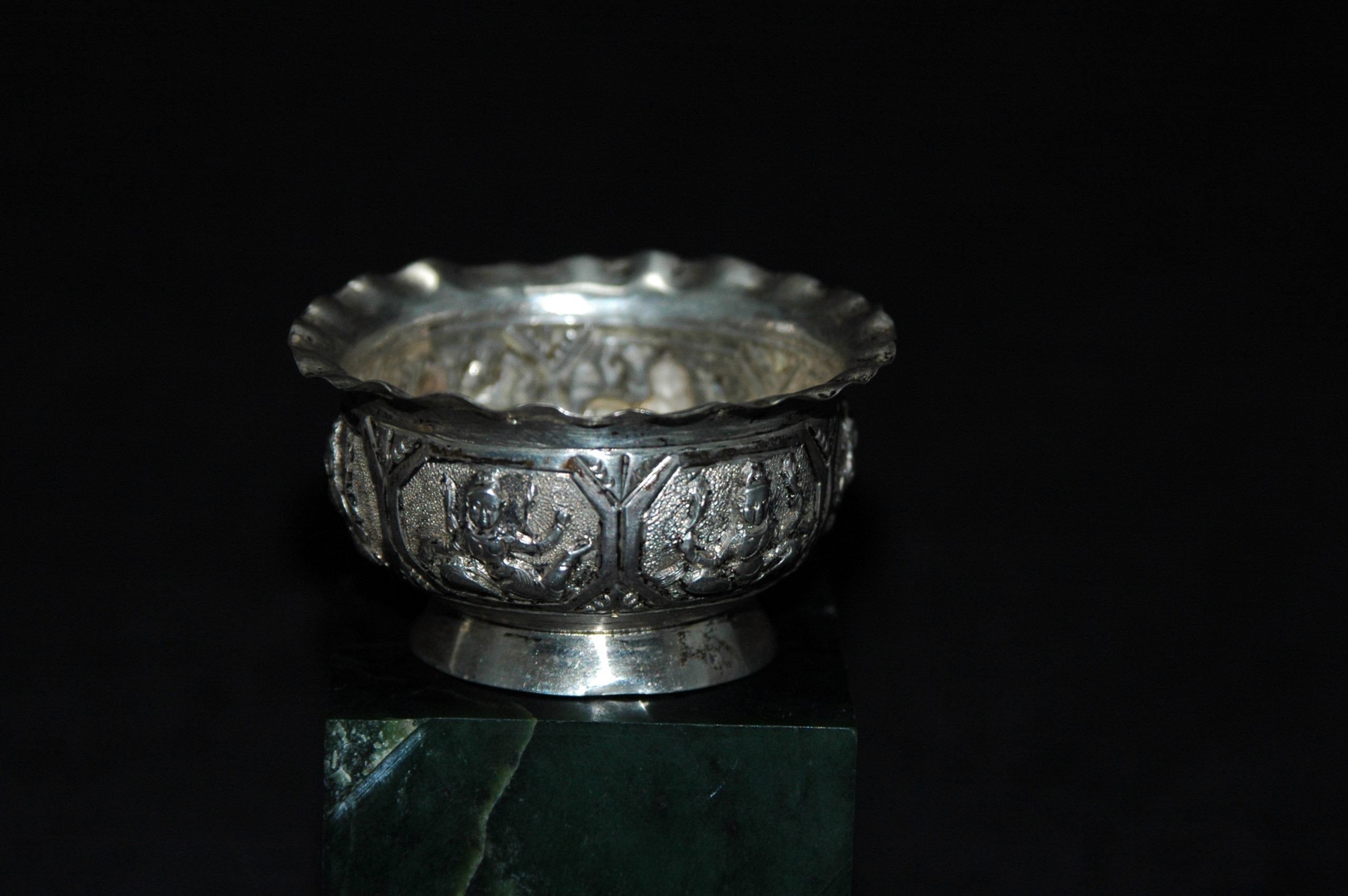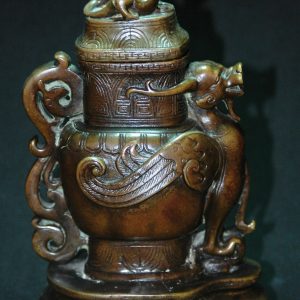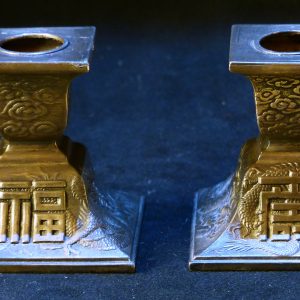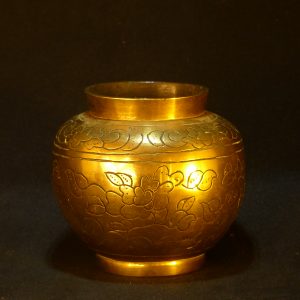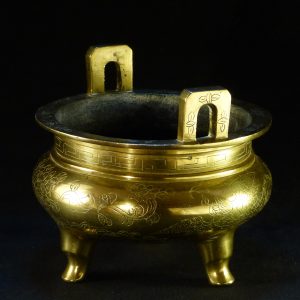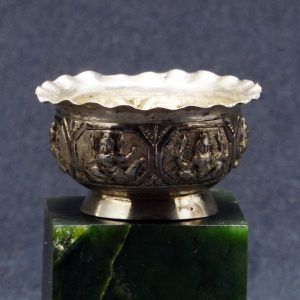Description
唐 开光錾佛像银杯
参考:佳士得
12 9月 2019| 現場拍賣 16950
重要中國瓷器及工藝精品
拍品 844
A RARE AND LARGE MOTTLED DARK GREEN JADE ALMS BOWL
PROPERTY FROM THE COLLECTION OF FREDERICK A. AND SHARON L. KLINGENSTEIN
清乾隆 青玉浮雕七佛缽
QIANLONG PERIOD (1736-1795)
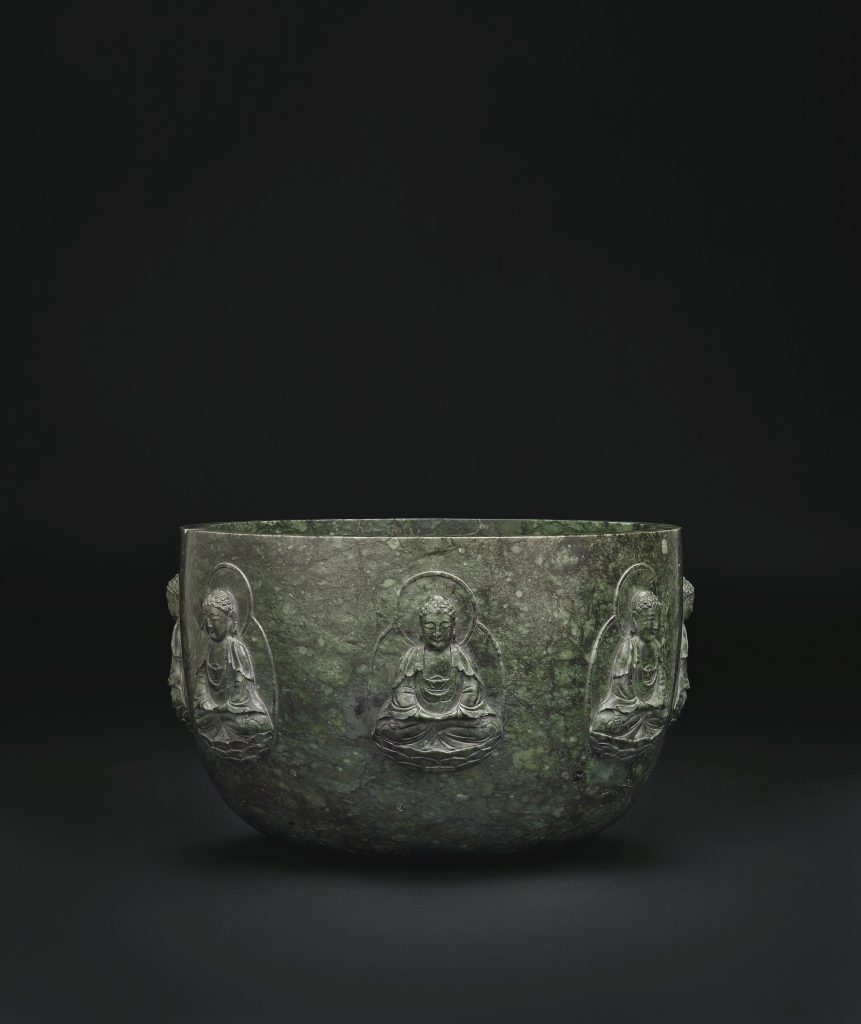
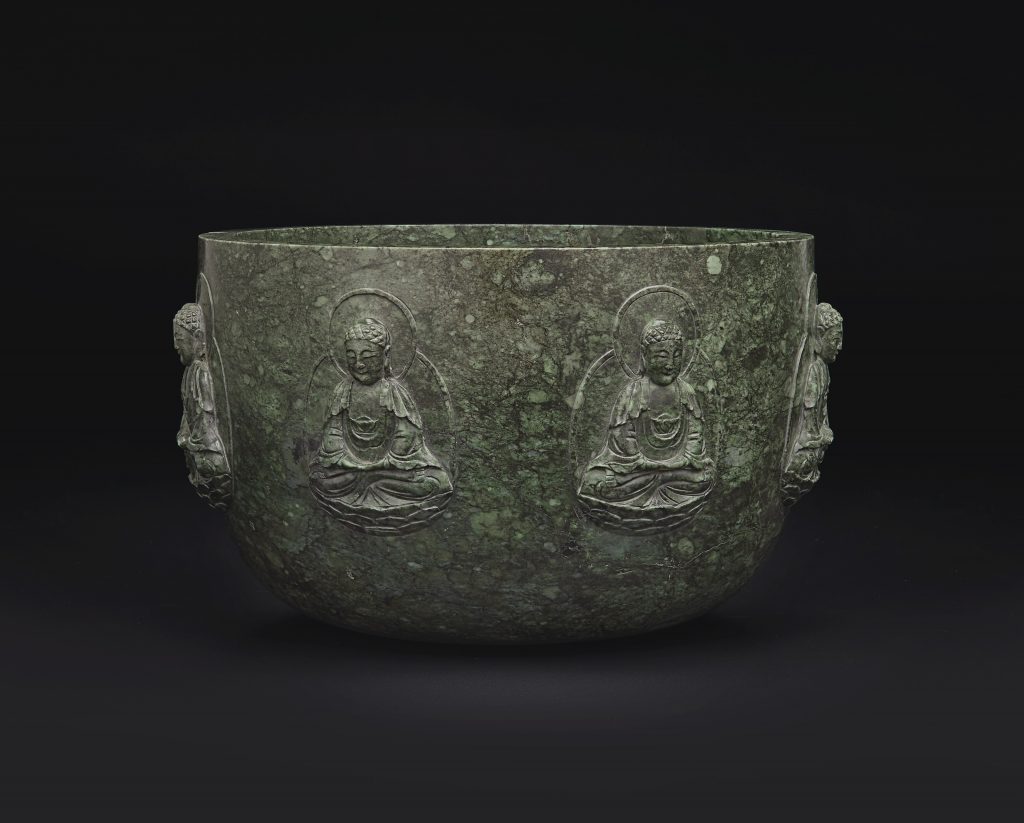
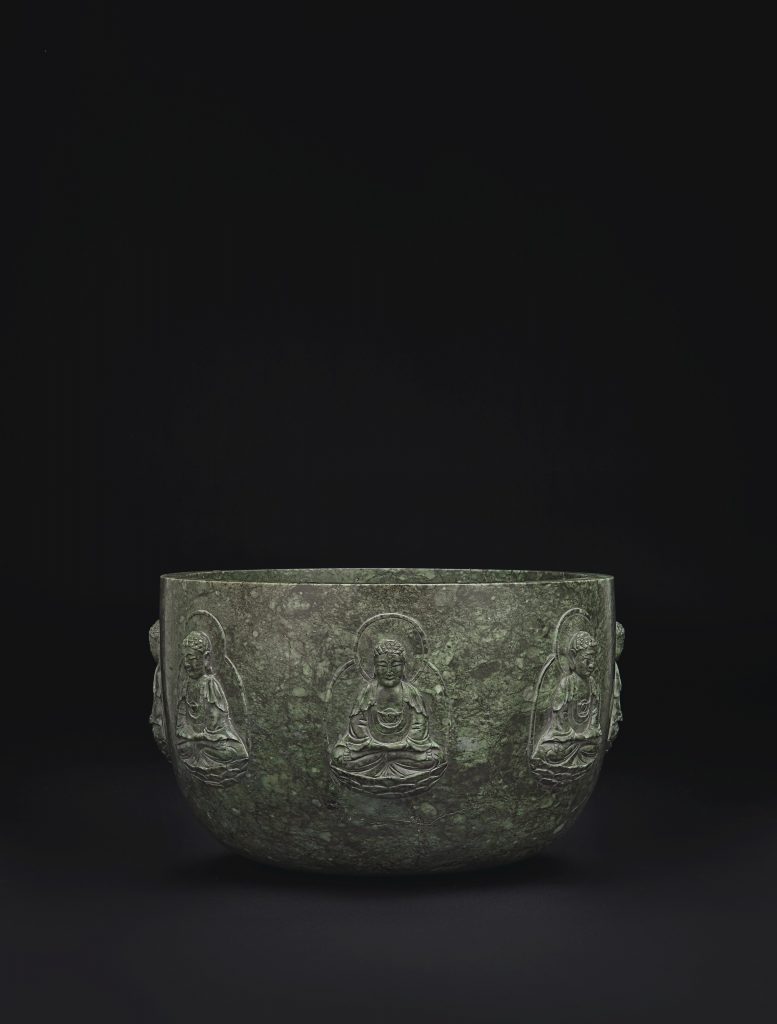
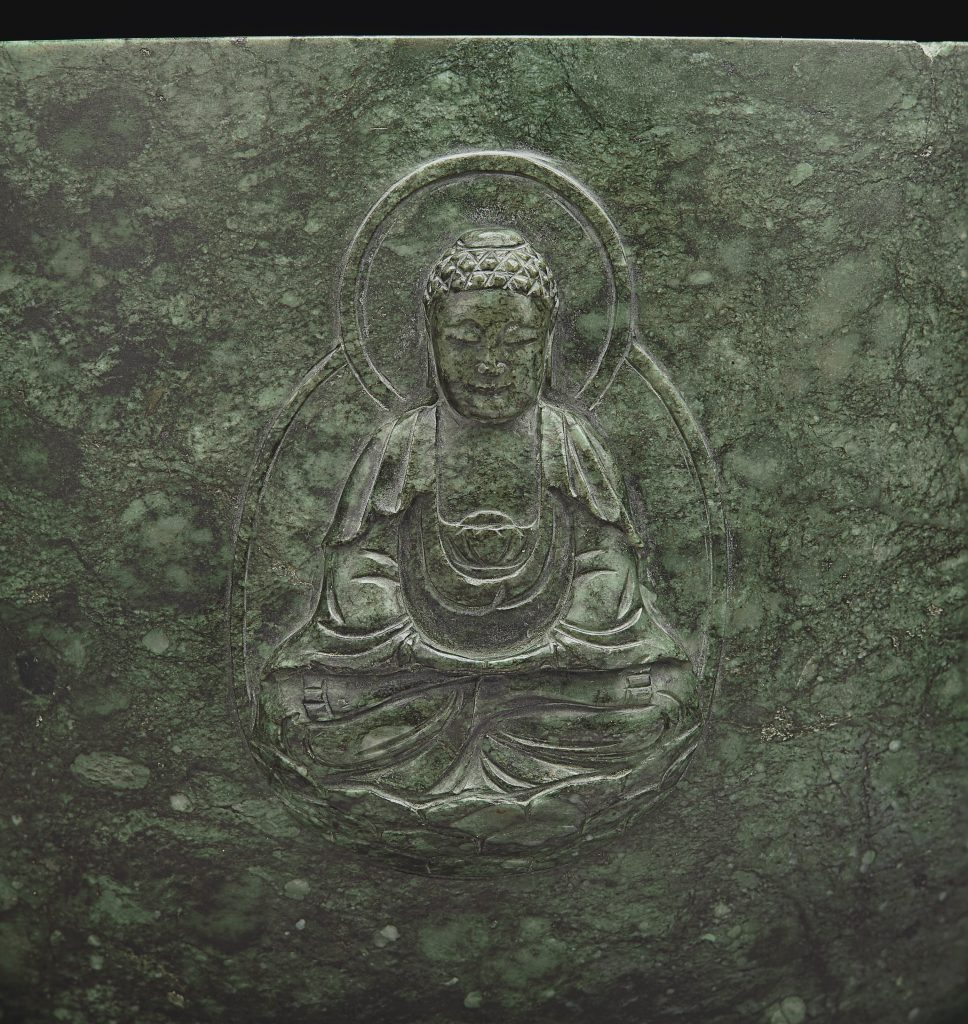
成交價 USD 237,500
估價 USD 200,000 – USD 300,000
清乾隆 青玉浮雕七佛缽
QIANLONG PERIOD (1736-1795)
9 ½ in. (24.1 cm.) diam.
來源
Eskenazi Ltd., London, 1992.
狀況報告
We have sought to record changes in the condition of this piece acquired after its initial manufacture.
-in overall good condition
-a small chip to the mouth rim with an associated faint crack measuring approx. 2.5 cm. long
-minor expected chips to the extremities including three Buddhas’ hands
-as can be seen in the catalogue illustrations, the stone has some inherent areas of lighter coloration and a few fissures
拍品專文
The exterior of the bowl is masterfully carved in high relief with seven figures of Buddha, all seated in dyanasana with two hands folded above the lap. These seven Buddhas are the historical Buddhas of this world, namely Vipasya, Siki, Visvabhu, Krokutachan, Nakanakamuni, Kasyapa and Sakyamuni.
The ‘Seven Historical Buddhas’ is considered one of the Qianlong Emperor’s favorite subjects. In 1770, the Emperor composed an essay on the Seven Buddhas to be inscribed on a tablet for the newly finished Seven Buddha Pagoda Pavilion outside the Forbidden City, see ‘The Eulogy on The Seven-Buddha-Tower Pavilion’, Qifuota bei ji, recorded in Second Compilation of Imperial Writings, juan 30. In the essay he mentioned that a Tibetan scroll sent as tribute by the Panchen Lama aroused his curiosity about these seven Buddhas, and he researched various sutras and consulted authorities, including his religious mentor, Changkya Rolpai Dorje, about these Buddhas. Finally he was able to trace their lineage, which was detailed in the essay. And it was to commemorate this that the pavilion was built, indicating the high regard he had for the subject.
In the Tang dynasty, the poet Pi Rixiu (c. AD 834-883) composed a poem on a green stone alms bowl in the Kaiyuan temple, supposedly once used by the Buddha himself, and somehow found its way to China. Having read the poem, the Qianlong Emperor made a special request to see this bowl when he visited the temple on his first Southern Tour. He was apparently very taken by the simple and archaic form of the bowl, and ordered the bowl to be copied in various materials.
In 1786, he composed a poem titled On a Seven-Buddha Bowl of Khotan Jade, with a very informative footnote:
“Although the alms bowl in the Kaiyuan Temple is not made of green stone, it is of archaic and elegant form. Upon returning I ordered a fine craftsman to make one using aloeswood, and inscribed on it with the names of the Buddhas and psalms furthermore, because aloeswood is not as durable as jade, I ordered to have this jade alms bowl made so one can pay tribute to it forever. (Fifth Compilation of Imperial Poems, juan 27)”
For a very similar white jade alms bowl in the Beijing Palace Museum, see The Complete Collection of the Treasures of the Palace Museum – Jadeware (III), Hong Kong, 1995, p. 146, no. 118. A celadon jade alms bowl with the name and psalm of each Buddha inscribed on the exterior in the Summer Palace (Yiheyuan) Collection, is illustrated in The Summer Palace Collection, Beijing, 2000, p. 53. A spinach-green jade example that bears inscriptions of psalms, in the Norton Gallery of Art, is illustrated by S. C. Nott in An Illustrated Record of the Stanley Charles Nott Collection of Chinese Jades, Florida, 1942, p. 348, no. 67. In addition, see a hongmu example with an incurved rim in the Palace Museum, Beijing, illustrated in The Palace Museum Collection of Elite Carvings, Beijing, 1999, no. 82. See, also, a bamboo alms bowl of the same form, also in the Beijing Palace Museum, illustrated in The Life of Emperor – Qian Long, Museu de Arte de Macau, 2002, no. 104. An aloeswood example with Qianlong’s inscription was sold at Christie’s London, 15 May 2007, lot 186.
参考:成都八益拍卖有限公司
2015年春季艺术品拍卖会
妙境梵音——金铜佛像·唐卡专场
LOT号: 0654 清 錾银酥油灯

拍品信息
尺寸 高26cm
作品分类 佛教文物>佛教文物其它
创作年代 清
估价 RMB 25,000-35,000
成交价
专场 妙境梵音——金铜佛像·唐卡专场
拍卖时间 2015-04-26
拍卖公司
成都八益拍卖有限公司已开通官网
拍卖会 2015年春季艺术品拍卖会
说明
说明:“酥油灯”由纯植物食用油脂精制而成的,火光稳定,持久,燃烧时散发清淡的天然奶油香味。多用于西藏的寺庙,或家中举行念经法事,还是为逝者作祭祀活动,都要点上几盏或上百盏酥油灯。经书上说,点酥油灯可以将世间变为火把,使火的慧光永不受阻,肉眼变得极为清亮,懂明善与非善之法,排除障视和愚昧之黑暗,获得智慧之心,使在世间永不迷茫于黑暗,转生高界,迅速全面脱离悲悯。酥油灯在藏传佛教信徒心中十分的重要,把酥油灯比做是信徒们的精神之灯一点都不过分。在藏传佛教的寺院中和信徒家中的佛龛前,一年四季都供奉着用酥油作燃油的长明灯。点酥油灯是供奉佛、法、僧三宝的主要方式之一。在佛像或佛塔前点供灯,表示佛光普照。酥油灯一般为金、银、铜、陶瓷等铸制而成,品类繁多,常见的样式有“格桑曲供”和“土登曲供”。酥油灯,藏语称“曲供”,所谓格桑曲供就是七世达赖喇嘛格桑嘉措时期流行的式样,土登曲供是十三世达赖喇嘛土登嘉措时期流行的式样。此件拍品正是“土登曲供”的典型样式,银质、撇口、鼓腹、长颈,灯碗外缘刻缠枝莲花,莲花采用錾刻技艺使其凸起,间有四处凸起菱花形开光,内分别錾饰上师、八宝纹、和睦四瑞图。藏传佛教中和睦四瑞图象征尊老爱幼,和平相处,源于《释迦牟尼本生传》;碗与底座之间由一鼓腹圆柱锤揲连接,锤揲精细,连接紧密;底座两层仰瓣莲为饰,莲也向上蜷曲,使得整器层次分明,更为稳重。
参考:佳士得 拍賣 4914
印度與伊斯蘭工藝精品及紡織品
倫敦南肯辛頓|2012年4月27日
拍品920 17世纪 鎏锡铜罐
A TINNED-COPPER VESSEL
SAFAVID IRAN, 17TH CENTURY
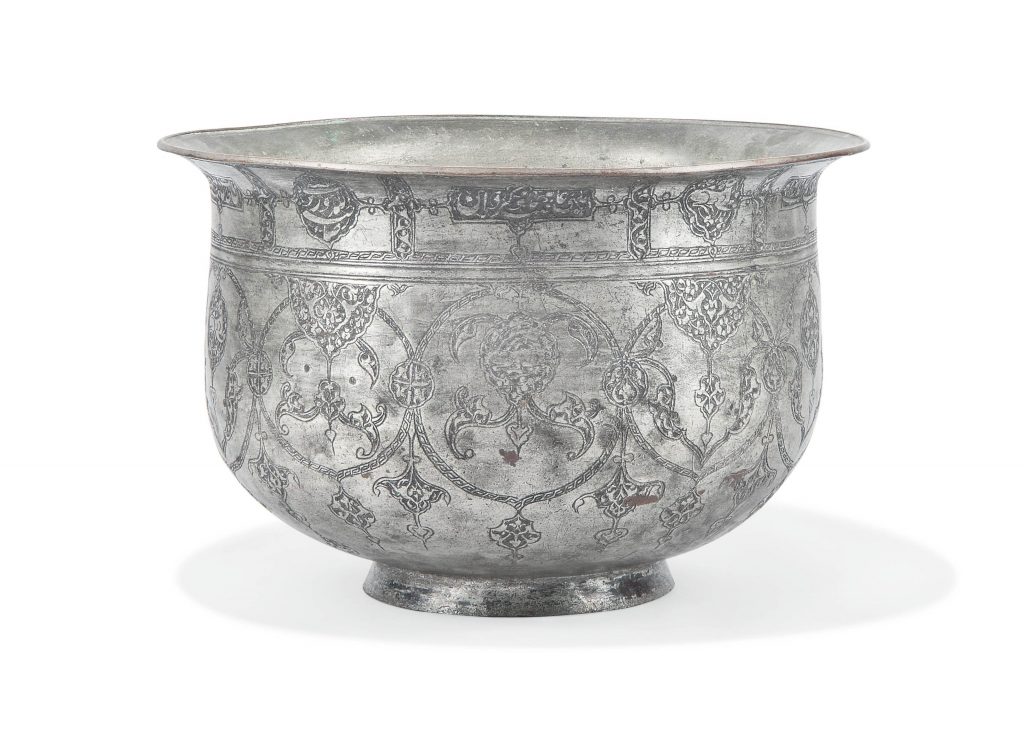
成交總額
GBP 2,125
估價
GBP 2,000 – GBP 3,000
A TINNED-COPPER VESSEL
SAFAVID IRAN, 17TH CENTURY
With sloping rim on short foot, the straight body decorated with palmettes and floral medallions, animal figures, the upper register with calligraphic cartouches in nastaliq script, an inscription on the base reading Muhammad Baqir
12¼in. (31cm.) diam.
拍賣 11421
錦瑟華年 – 安思遠私人珍藏
第四部分:中國工藝精品 ─ 金屬器、雕塑及早期瓷器
紐約|2015年3月20日
拍品730
南宋/元 銀局部鎏金六瓣形盞及盞托
CHINA, SOUTHERN SONG-YUAN DYNASTY (1127-1368)
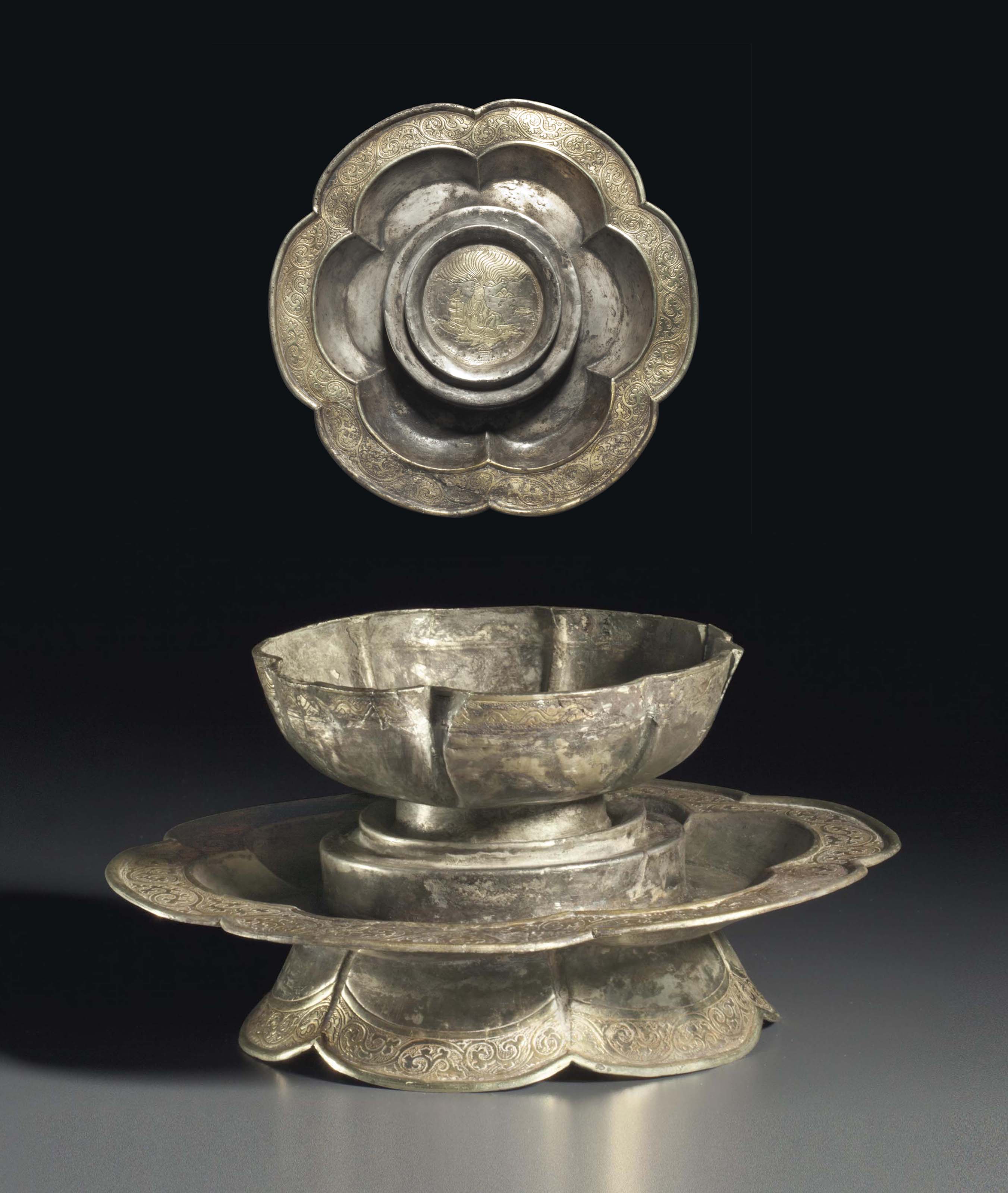
南宋/元 銀局部鎏金六瓣形盞及盞托
成交總額
USD 43,750
估價
USD 3,000 – USD 5,000
南宋/元 銀局部鎏金六瓣形盞及盞托
参考:佳士得拍賣 18338
金紫銀青 – 中國早期金銀器粹珍
紐約|2019年9月12日
拍品554
唐 銀局部鎏金鏨刻雁穿花紋四曲小長盃
TANG DYNASTY (AD 618-907)
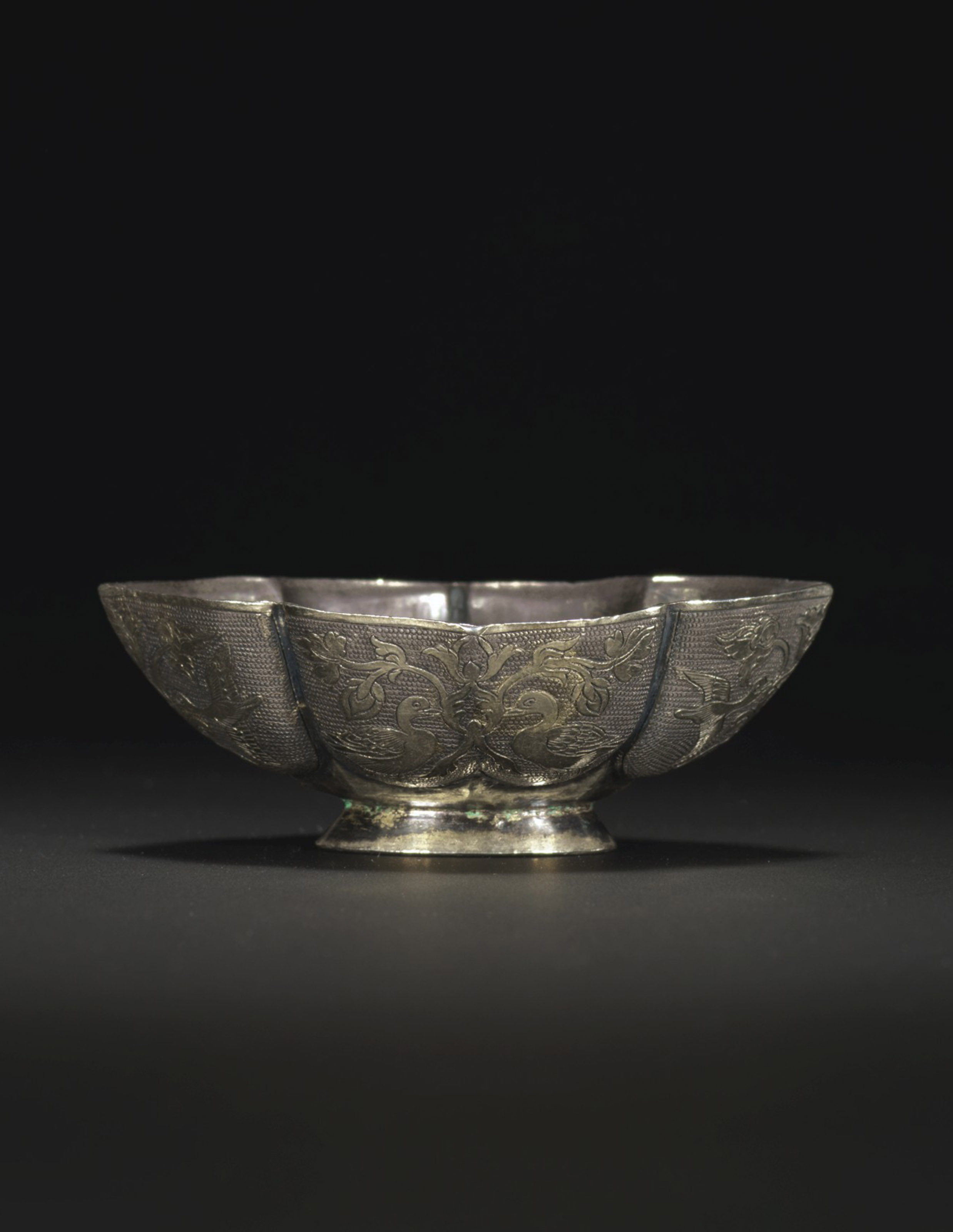
唐 銀局部鎏金鏨刻雁穿花紋四曲小長盃
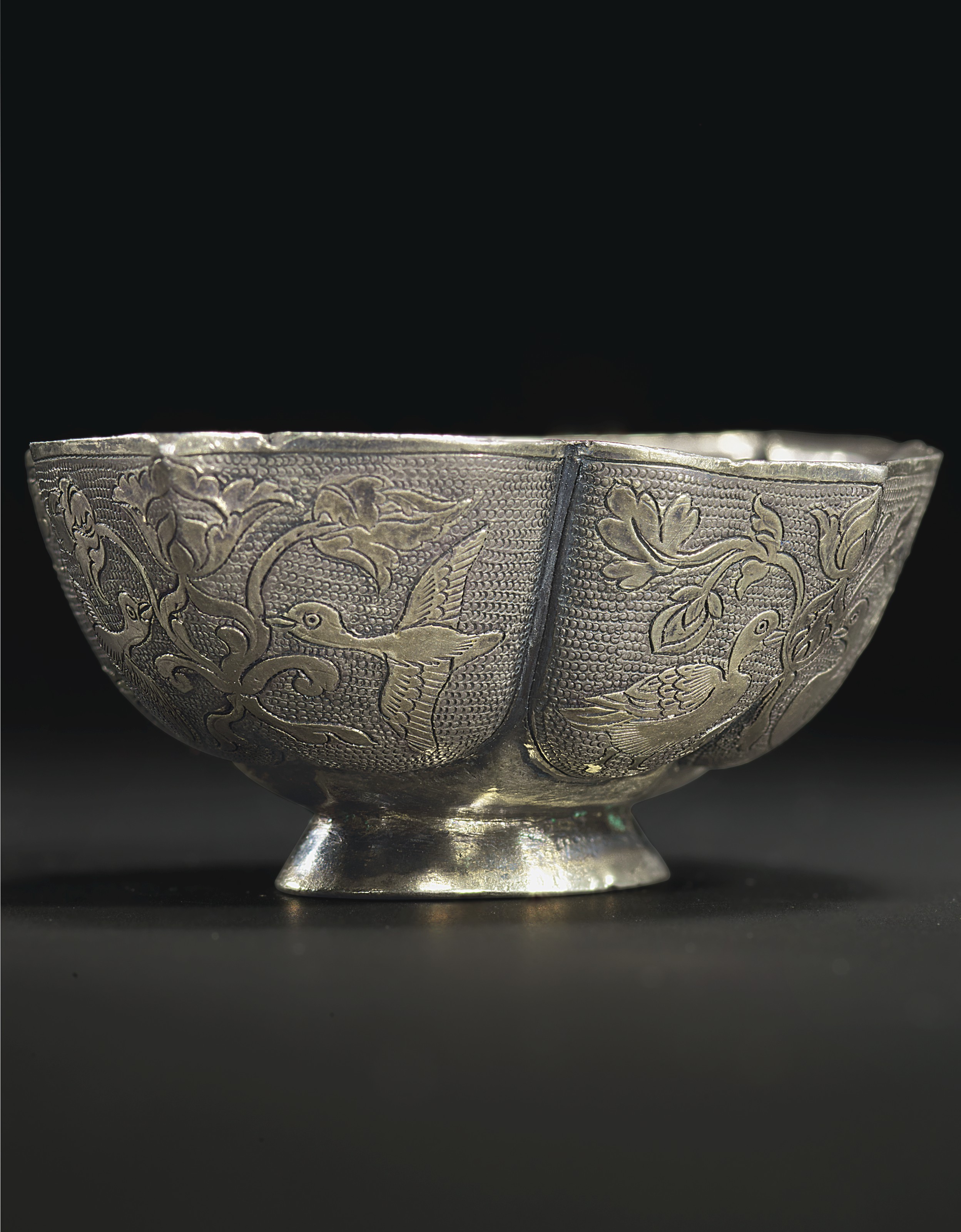
唐 銀局部鎏金鏨刻雁穿花紋四曲小長盃
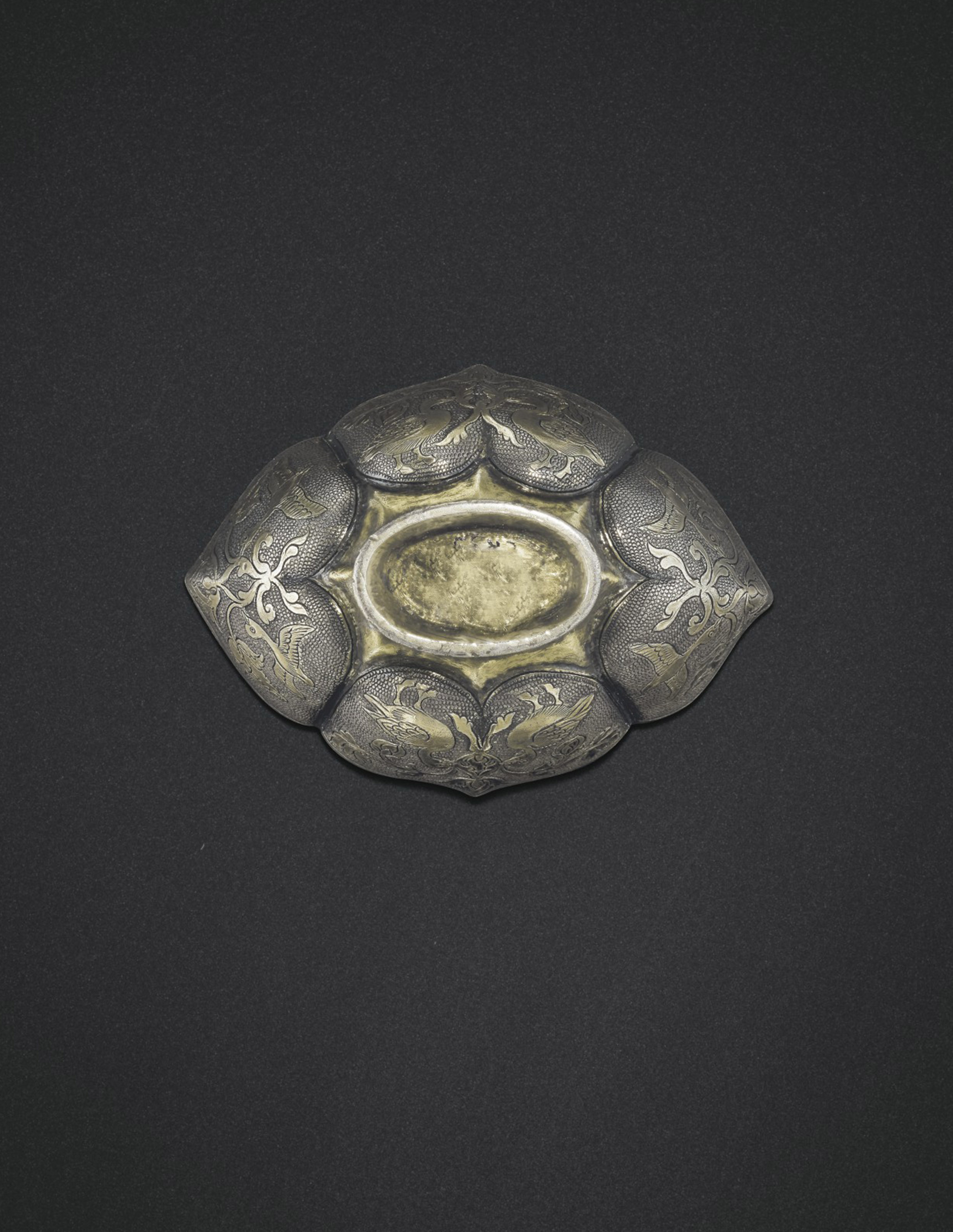
唐 銀局部鎏金鏨刻雁穿花紋四曲小長盃
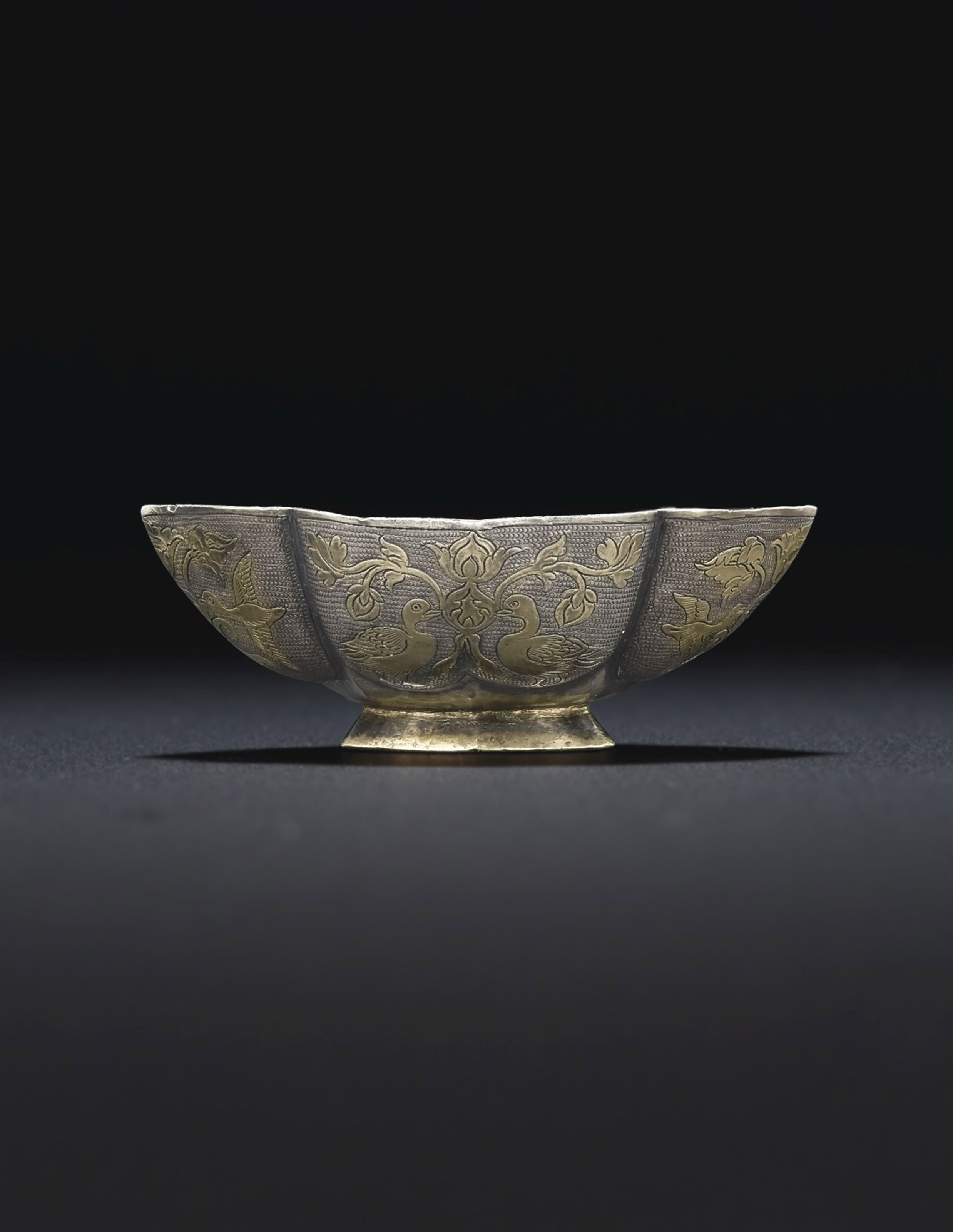
唐 銀局部鎏金鏨刻雁穿花紋四曲小長盃
成交總額
USD 262,500
估價
USD 50,000 – USD 70,000
唐 銀局部鎏金鏨刻雁穿花紋四曲小長盃
2 ¼ in. ( 5.7 cm.) wide; weight 27.5 g
來源
Dr. Johan Carl Kempe (1884-1967) Collection, Sweden, before 1953, no. CK95.
Sotheby’s London, Masterpieces of Chinese Precious Metalwork. Early Gold and Silver, 14 May 2008, lot 53.
文獻及展覽
文獻
Bo Gyllensvärd, Chinese Gold and Silver in the Carl Kempe Collection, Stockholm, 1953, cat. no. 95.
Bo Gyllensvärd, ‘T’ang Gold and Silver’, Bulletin of the Museum of Far Eastern Antiquities, No. 29, Stockholm, 1957, pl. 11b, fig. 68c, fig. 69a.
Han Wei, Hai nei wai Tangdai jin yin qi cui bian, [Tang Gold and Silver in Chinese and overseas collections], Xi’an, 1989, pl. 82.
Chinese Gold and Silver in the Carl Kempe Collection, The Museum of Art and Far Eastern Antiquities in Ulricehamn, Ulricehamn, 1999, pl. 97.
Qi Dongfang, Tangdai jin yin qi yan jiu [Research on Tang gold and silver], Beijing, 1999, pl. 19.
展覽
Washington, D.C., Smithsonian Institution, Chinese Gold and Silver in the Carl Kempe Collection, 1954-1955, cat. no. 95.
New York, Asia House Gallery, Chinese Gold, Silver and Porcelain. The Kempe Collection, 1971, cat. no. 43, an exhibition touring the United States and shown also at nine other museums.
Oxford, Ashmolean Museum, From Silver to Ceramic, the Potter’s Debt to Metal Work in the Graeco-Roman, Oriental and Islamic Worlds, 1986, pl. 31 (bottom).
拍品專文
Cups of this oblong, quatrefoil shape appear to be rare. One raised on a higher foot, in the Pierre Uldry Collection, is illustrated in Chinesisches Gold und Silber, Zurich, 1994, p. 152, pl. 138. A larger (11.7 cm. long) quadrilobed bowl with rounded sides, rather than barbed petal lobes, decorated on the exterior with foliate scroll on a ring-punched ground, but raised on a low, quadrilobed foot, in The Frederick M. Mayer Collection of Chinese Art, was sold at Christie’s London, 24-25 June 1974, lot 167. A plain beaten silver quadrilobed bowl with straight, flared sides, its lobes formed by indentations, in the collection of Mr. and Mrs. Rafi Y. Mottahedeh, is illustrated by Dr. Paul Singer, Early Chinese Gold & Silver, China Institute in America, New York, 1971, p. 58, no. 78, where it is dated Tang.
Bowls of lobed oblong shape are more often found with eight lobes, and of larger size, such as the example in the Asian Art Museum of San Francisco, The Avery Brundage Collection, illustrated by Clarence W. Kelley, Tang Dynasty, Chinese Gold & Silver in American Collections, The Dayton Art Institute, Dayton, Ohio, 1984, p. 65, no. 31. Another with eight lobes (15.2 cm. long) is illustrated in Sui to no bijutsu, Osaka Municipal Art Museum, 1976, no. 2-16. The origins of these lobed, oval bowls appear to be Sassanian, as evidenced by the parcel-gilt silver, lobed elliptical bowl raised on a slightly flared, oval foot ring, dated 6th century, illustrated by Ann C. Gunter and Paul Jett, Ancient Iranian Metalwork in the Arthur M. Sackler Gallery and the Freer Gallery of Art, Washington, D.C., 1992, p. 182, pl. 31.
参考:佳士得拍卖 11421 锦瑟华年 – 安思远私人珍藏
第四部分:中国工艺精品 ─ 金属器、雕塑及早期瓷器 纽约|2015年3月20日 拍品733 南宋 錾银花纹高足杯 A PAIR OF SILVER BRACKET-LOBED FLORIFORM STEM BOWLS CHINA, SOUTHERN SONG-YUAN DYNASTY (1127-1368)
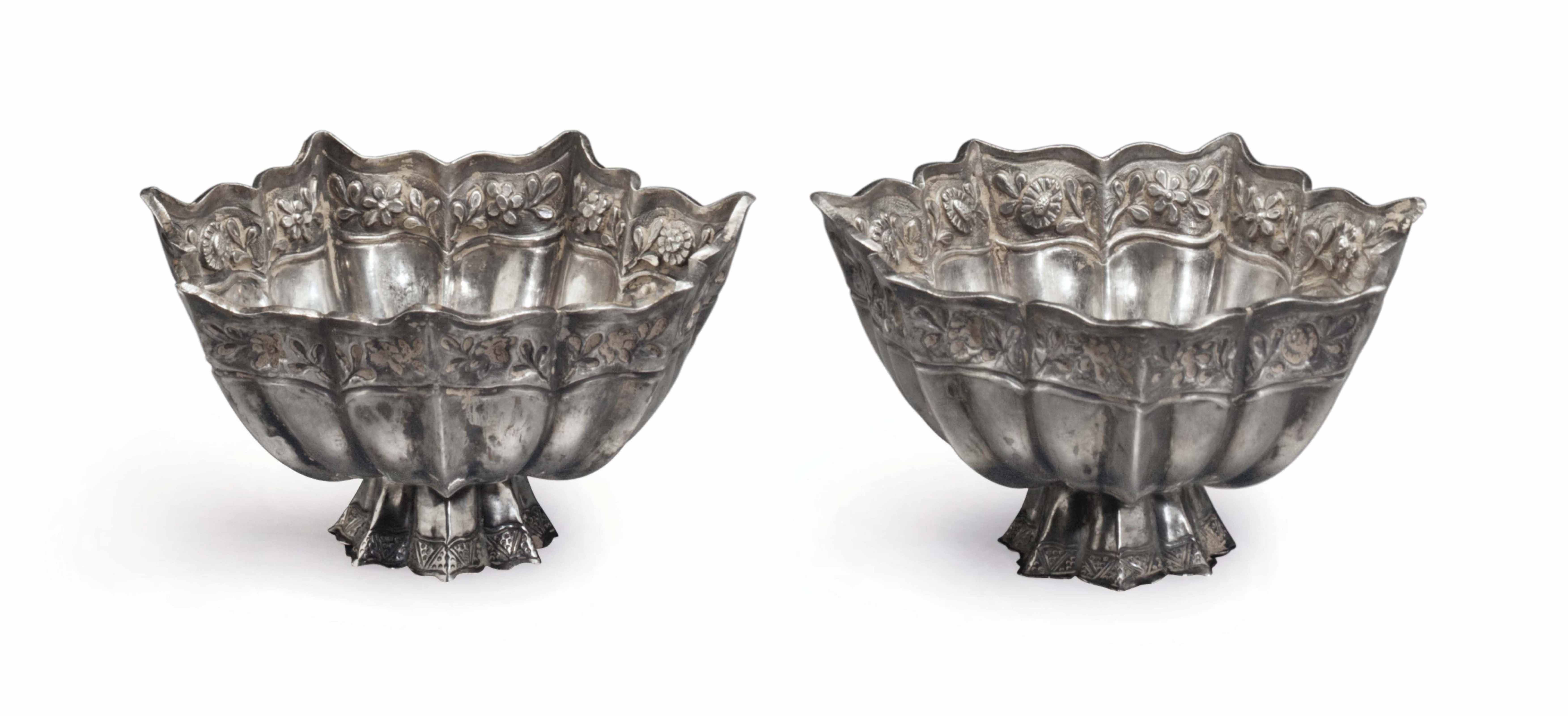
第四部分:中国工艺精品 ─ 金属器、雕塑及早期瓷器
纽约|2015年3月20日 拍品733 南宋 錾银花纹高足杯 A PAIR OF SILVER BRACKET-LOBED FLORIFORM STEM BOWLS CHINA, SOUTHERN SONG-YUAN
成交总额
USD 47,500
估价
USD 7,000 – USD 9,000
此拍品不设底价
A PAIR OF SILVER BRACKET-LOBED FLORIFORM STEM BOWLS
CHINA, SOUTHERN SONG-YUAN DYNASTY (1127-1368)
The sides of each bowl in the form of seven barbed petals radiating from the raised, pointed center, each petal chased just below the rim with a pair of flower sprigs, all forming a continuous band, the whole raised on a conforming pedestal foot chased with a diaper border
4 ¼ in. (10.7 cm.) wide, box
134 g
拍卖现场通告
Please note that the date for this lot should read: CHINA, SOUTHERN SONG-YUAN DYNASTY (1127-1368).
參考:紐約大都會博物館 唐 银 杯 Wine Cup, Silver,
China


Object Details
Period:Tang dynasty (618–907)
Culture:China
Medium:Silver
Dimensions:H. 2 1/2 in. (6.4 cm); Diam. 1 1/4 in. (3.2 cm)
Classification:Metalwork
Credit Line:Rogers Fund, 1923
Accession Number:23.247
Provenance
[ Yamanaka & Co. , until 1923; sold to MMA]
Timeline of Art History
Timelines
Central and North Asia, 500-1000 A.D.
China, 500-1000 A.D.

![[临渊阁]天地一家春](https://www.antiquekeeper.ca/wp-content/uploads/2023/03/cropped-Asian-Art-Wallpaper-Painting3-6-2.jpg)
